
Cook's First Voyage
First voyage of captain james cook.
(1768 - 1771)
James Cook’s first voyage circumnavigated the globe in the ship Endeavour , giving the botanists Joseph Banks and Daniel Solander the opportunity to collect plants from previously unexplored habitats. Although the Endeavour voyage was officially a journey to Tahiti to observe the 1769 transit of Venus across the sun, it also had a more clandestine mission from the Royal Society to explore the South Pacific in the name of England. The two botanists on the expedition returned with a collection of plant specimens including an estimated 100 new families and 1,000 new species of plants, many of which are currently housed in the U. S. National Herbarium.
Joseph Banks, who would later become Sir Joseph Banks and president of the Royal Society, was a wealthy young scientist. He invited his close friend Daniel Solander, a Swedish student of Linnaeus working in the natural history collections of the British Museum, to join him on the Endeavour expedition. Together they acted as the naturalists on the voyage, commanding several servants and artists, including Sydney Parkinson, and outfitted with an excellent array of scientific equipment. After setting out from London, the expedition stopped briefly at Madeira, a small Portuguese island in the Atlantic Ocean, and then continued on to Rio de Janiero, on the eastern coast of Brazil. Here, the expedition encountered one of its first major setbacks when the Portuguese governor Dom Antonio Rolim de Moura Tavare refused to allow anyone from the Endeavour to come on land except to acquire necessities. This restriction, however, didn’t stop the two determined botanists. Banks and Solander risked being arrested as spies or smugglers in order to sneak onshore to collect specimens around the city. Despite this difficulty, the expedition traveled on to Tierra del Fuego at the southern tip of South America, where they collected a large number of specimens despite bitterly cold weather that killed two members of the crew. In April of 1769, the expedition reached Tahiti, where they stayed until July. During this time, Banks and Solander collected over 250 plant species, including the orchids Liparis revoluta and Oberonia equitans (also known as Oberonia disticha ) and the flowering plant Ophiorrhiza solandri , in the first extensive botanical study in Polynesia.
After viewing the transit of Venus on June 3, 1769, the expedition began mapping, exploring, and collecting specimens in the relatively unknown regions of New Zealand and the eastern coast of Australia (then called New Holland). Plants collected included the large orchid Dendrobium cunninghamii , also known as Winika cunninghamii , native to the western shore of New Zealand, as well as white-honeysuckle ( Banksia integrifolia ), native to the east coast of Australia. The Endeavour stopped for nine days at a bay on the coast of Australia, where, according to Banks, the expedition’s plant collection became “so immensely large that it was necessary that some extraordinary care should be taken of them least they should spoil.” The botanists were so successful that Cook decided to name the place Botany Bay in honor of their extensive discoveries.
The Endeavour continued its voyage mapping the eastern coast of Australia, narrowly avoiding shipwreck on the Great Barrier Reef, until it re-entered known waters near New Guinea in late August, 1770. During the last part of the voyage, the Endeavour stopped at the disease-ridden city of Batavia in Java and at the Cape of Good Hope in Africa, returning to England in July, 1771. Overall, the expedition was very successful, with little strife among the crew and no deaths from scurvy. Although neither Banks nor Solander published their botanical findings, the two naturalists returned to England with a vast wealth of new discoveries.
References:
Adams, Brian. The Flowering of the Pacific . Sydney: William Collins Pty, 1986. Allen, Oliver E. The Pacific Navigators . Canada: Time-Life Books, 1980. Global Biodiversity Information Facility (GBIF) database, http://gbif.org/ (for information on plant species Dendrobium cunninghamii ; accessed June 15, 2010). Ebes, Hank. The Florilegium of Captain Cook’s First Voyage to Australia: 1768-1771 . Melbourne: Ebes Douwma Antique Prints and Maps, 1988. Encyclopedia of Life (EOL) database, http://www.eol.org/ (for information on plant species Oberonia disticha and Dendrobium cunninghamii ; accessed June 15, 2010). Merrill, Elmer Drew. The Botany of Cook’s Voyages and its Unexpected Significance in Relation to Anthropology, Biogeography and History . Waltham, Massachusetts: Chronica Botanica Co., 1954. O’Brian, Patrick. Joseph Banks: A Life . Boston: David R. Gardine, Publisher, 1993. Rauchenberg, Roy A. “Daniel Carl Solander: Naturalist on the ‘Endeavour’,” Transactions of the American Philosophical Society , New Series, 58, no. 8 (1968): 1-66. http://www.jstor.org/stable/1006027 (May 26, 2010). National Library of Australia. “South Seas: Voyaging and Cross-Cultural Encounters in the Pacific.” South Seas , n.d. http://southseas.nla.gov.au/ . Contains maps and text of expedition journals by James Cook and Joseph Banks. USDA PLANTS database. United States Department of Agriculture, Natural Resources Conservation Service. National Plant Data Center. http://plants.usda.gov/ (for information on plant species Banksia integrifolia ; accessed June 15, 2010).
- Smithsonian Institution
- Terms of Use
- Privacy Policy
- Host an Event
June 3 dawned crystal clear, and for six hours, in temperatures rising to 119°F, the men did the best they could, but their astronomical observations of Venus were hindered by a dusky cloud surrounding the planet. For a week at the end of the month, Cook, with a small party, took the ship’s pinnace and circled the island so that he could chart it, a rather daring feat considering his vulnerability. Before leaving Tahiti on July 13, he had to deal with an attempted desertion by two crewmen and the kidnap and counterkidnap of Tahitian chiefs and British crew members to resolve this escalating problem. At the last moment, he reluctantly agreed to the addition of Tupaia, a young Tahitian priest and interpreter who wanted to join Banks’s party.

Bénard, Robert, fl. 1750–1785 . “Baye de Matavai à Otahiti ; Havre d’Ohamaneno à Ulietea ; Havre d’Owharre dans l’isle d’Huaheine : Havre d’Oopoa à Ulietea.” Four copperplate maps on 1 sheet, with added color, 12 × 15 cm. or smaller, on sheet 27 × 40 cm. From Hawkesworth’s Relation des voyages entrepris par ordre de Sa Majesté Britannique . . . (Paris, 1774) [Historic Maps Collection]. Point Venus in Matavai Bay was the site of Cook’s observation of the transit of Venus in June 1769.

Breadfruit. [Hawkesworth, vol. 2, plate 3]
The bread-fruit grows on a tree that is about the size of a middling oak: its leaves are frequently a foot and a half long, of an oblong shape, deeply sinuated like those of a fig-tree, which they resemble in consistence and colour, and in the exuding of a white milkey juice upon being broken. The fruit is about the size and shape of a child’s head, and the surface is reticulated not much unlike a truffle: it is covered with a thin skin, and has a core about as big as the handle of a thin knife: the eatable part lies between the skin and the core; it is as white as snow, and somewhat of the consistence of new bread: it must be roasted before it is eaten. . . . [vol. 2, p. 80]

Hogg, Alexander, fl. 1778–1819. “Chart of the Society Isles Discovered by Captn. Cook, 1769.” Copperplate map, with added color, 22 × 34 cm. From G. W. Anderson’s A New, Authentic and Complete Collection of Voyages Around the World, Undertaken and Performed by Royal Authority . . . (London, 1784). [Historic Maps Collection]

New Zealander Tattoos. [Hawkesworth, vol. 3, plate 13]
The bodies of both sexes are marked with black stains called Amoco, by the same method that is used at Otaheite, and called Tattowing; but the men are more marked, and the women less. . . . [T]he men, on the contrary, seem to add something every year to the ornaments of the last, so that some of them, who appeared to be of an advanced age, were almost covered from head to foot. Besides the Amoco, the have marks impressed by a method unknown to us, of a very extraordinary kind: they are furrows of about a line deep, and a line broad, such as appear on the bark of a tree which has been cut through . . . and being perfectly black, they make a most frightful appearance. . . . [W]e could not but admire the dexterity and art with which they were impressed. The marks upon the face in general are spirals, which are drawn with great nicety, and even elegance, those on one side exactly corresponding with those on the other. . . . [N]o two were, upon a close examination, found to be alike. [vol. 3, pp. 452–53]

“Carte de la Nle. Zelande visitée en 1769 et 1770 par le Lieutenant J. Cook Commandant de l’Endeavour, vaisseau de sa Majesté.” Copperplate map, with added color, 46 × 36 cm. From John Hawkesworth’s Relation des voyages entrepris par ordre de Sa Majesté Britannique . . . (Paris, 1774). French copy of Cook’s foundation map of New Zealand, showing the track of the Endeavour around both islands, from October 6, 1769, to April 1, 1770. [Historic Maps Collection]
Endeavour came within sight of land on April 19, well north of the area charted by Tasman 125 years earlier. The New Holland (Australia) coast was exasperating, however, and Cook could not find a safe place to land until the afternoon of Saturday, April 28, when they entered Botany Bay (part of today’s Sydney Harbor), which Cook later named for the wide variety of plant life found there. The Aborigines that they saw there were unintelligible to Tupaia and kept away, avoiding contact. Through May and into June, Endeavour sailed north, arcing northwest, following the Great Barrier Reef coastline. On the evening of June 10, when most of the men were sleeping, the ship struck coral, stuck fast, and began leaking. Quick thinking and decisive action by Cook and his men—pumping furiously and jettisoning fifty tons of decayed stores, stone ballast, and cannons—kept the ship afloat and allowed a temporary underwater repair. A few days later, the damaged ship was safely beached on a barren shore (near today’s Cooktown, by the EndeavourRiver), and a fury of activity began more permanent work: the expedition had avoided a real disaster. (Henceforth, the British Admiralty would send Cook out with two ships for safety.) During this time, the men enjoyed more favorable interactions with the natives, but not without miscommunications and incidents of distrust. (See the box on Cook’s ultimately positive views on the New Hollanders.) By August 13, the ship was ready to resume its journey. The labyrinth of treacherous islands and reefs was threaded slowly and carefully, with vigilance and some luck, as the expedition sailed northward through the Great Barrier Reef, westward around the northernmost point of New Holland, and into what Cook called Endeavour Strait. He stopped briefly at Possession Island (his name) where, now knowing he was in territory explored by the Dutch, he claimed the whole coastline he had just charted for King George III. It was a proud moment, essentially marking the end of Cook’s first Pacific voyage’s geographical discoveries.

Bonne, Rigobert, 1727–1794. “Nlle. Galles Mérid.le [i.e. Nouvelle Galles Méridionale], ou, Côte orientale de la Nouvelle Hollande.” Copperplate map, with added color, 34 × 17 cm. Plate 137 from vol. 2 of R. Bonne and N. Desmarest’s Atlas Encyclopédique . . . (Paris, 1788). [Historic Maps Collection]
Places to note include Botany Bay (B. de Bontanique) around 34°, part of today’s Sydney, highlighted in an inset, and Endeavour River (Riv. Endeavour) at the top, between 15° and 16°, where the ship was repaired. The large inset at the bottom left shows the part of Tasmania explored by Captain Tobias Furneaux of the Adventure during Cook’s second voyage.

Beached Endeavour and Examination of Its Damage. [Hawkesworth, vol. 3, plate 19]
In the morning of Monday the 18th [June 1770], a stage was made from the ship to the shore, which was so bold that she floated at twenty feet distance: two tents were also set up, one for the sick, and the other for stores and provisions, which were landed in the course of the day. We also landed all the empty water casks, and part of the stores. . . . At two o’clock in the morning of the 22d, the tide left her, and gave us an opportunity to examine the leak, which we found to be at her floor heads, a little before the starboard fore-chains. In this place the rocks had made their way through four planks, and even into the timbers; three more planks were much damaged, and the appearances of these breaches was very extraordinary: there was not a splinter to be seen, but all was as smooth, as if the whole had been cut away by an instrument: the timbers in this place were happily very close, and if they had not, it would have been absolutely impossible to have saved the ship. But after all, her preservation depended upon a circumstance still more remarkable: in one of the holes, which was big enough to have sunk us, if we had eight pumps instead of four, and been able to keep them incessantly going, was in great measure plugged up by a fragment of the rock, which, after having made the wound, was left sticking in it. . . . By nine o’clock in the morning the carpenters got to work upon her, while the smiths were busy in making bolts and nails. [vol. 3, pp. 557, 559–60]

Kangaroo. [Hawkesworth, vol. 3, plate 20]
As I was walking this morning at a little distance from the one ship, I saw myself one of the animals which had been so often described: it was of a light mouse colour, and in size and shape very much resembling a greyhound; it had a long tail also, which it carried like a greyhound; and I should have taken it for a wild dog, if instead of running, it had not leapt like a hare or deer: its legs were said to be very slender, and the print of its foot to be like that of a goat. . . . [vol. 3, p. 561]
Natives of New Holland
From what I have said of the Natives of New-Holland they may appear to some to be the most wretched people upon Earth, but in reality they are far more happier than we Europeans; being wholly unacquainted not only with the superfluous but the necessary Conveniences so much sought after in Europe, they are happy in not knowing the use of them. They live in a Tranquillity which is not disturb’d by the Inequality of Condition: The Earth and sea of their own accord furnishes them with all things necessary for life, they covet not Magnificent Houses, Household-stuff &c., they live in a warm and fine Climate and enjoy a very wholesome Air. . . . In short they seem’d to set no Value upon any thing we gave them, nor would they ever part with any thing of their own for any one article we could offer them; this in my opinion argues that they think themselves provided with all the necessarys of Life and that they have no superfluities. [ Journals , p. 174]
In Batavia (today’s Jakarta, Indonesia), where Endeavour anchored on October 7, 1770, there was English news! American colonists had refused to pay taxes, and the king had dispatched troops to put down the first signs of a rebellion. Because of Cook’s strict insistence on a clean ship, exercise, and a healthy diet (including scurvy-preventing sauerkraut) for his crew, he had, until then, lost no man to sickness. Now, in one of the most diseased foreign cities, malaria, dysentery, and other ills began their work: almost everyone got sick during the months they remained on the island for refit and repair, and many died, including the Tahitian, Tupaia. Even after Cook left for home (December 26), the unfortunate deaths continued—thirty-four in all by the time they reached Cape Town in March—and five more would die there or on the last leg back to England. (Never failing to provide milk for the officers, Wallis’s goat was among the elite, having survived its second circumnavigation.) Endeavour docked in the Downs on July 12, 1771. The three men—Cook, Banks, and Solander—companions during more than a thousand days at sea, now shared a seven-hour post-chaise trip through Kent to London—riding into history. The botanists had brought back a wealth of scientific data about plant and animal species, including thousands of plants never seen in England as well as the amazing drawings of Sydney Parkinson and Alexander Buchan, the expedition’s artists, who had both died on the voyage. Cook had recorded his observations of the life and customs of the Polynesians of Tahiti, the Maori of New Zealand, and the Aborigines of Australia. And he had his accurate charts, which would immediately improve the mapping of the Pacific Ocean.

Zatta, Antonio, fl. 1757–1797. “Nuove scoperte fatte nel 1765, 67, e 69 nel Mare del Sud” (1776). Copperplate map, with added color, 29 × 39 cm. From Zatta’s Atlante novissimo (Venice, 1775–1785). Reference: Perry and Prescott, Guide to Maps of Australia , 1776.01. [Historic Maps Collection]
First decorative map to show Cook’s tracks in the Pacific, recording the discoveries he made in Australia, New Zealand, New Guinea, and the South Pacific during the Endeavour voyage. Also noted are the tracks of Philip Carteret, John Byron, and Samuel Wallis. The chartings of the east coast of Australia and New Zealand’s two islands are shown in detail, drawn from Cook’s own map of the region, “Chart of Part of the South Seas” (1773). The ship depicted is most probably the Endeavour .
Search Google Appliance
First voyage of captain james cook (1768 - 1771), usage conditions apply, description.
James Cook’s first voyage circumnavigated the globe in the ship Endeavour, and gave scientific members of the expedition an opportunity to collect specimens from previously unexplored habitats. Although the voyage was officially a journey to Tahiti to observe the 1769 transit of Venus across the sun, it also had a more clandestine mission from the Royal Society to explore the South Pacific in the name of England. Work was completed by botanists Joseph Banks and Daniel Solander. Joseph Banks, who would later become Sir Joseph Banks and president of the Royal Society, was a wealthy young scientist. He invited his close friend Daniel Solander, a Swedish student of Linnaeus working in the natural history collections of the British Museum, to join him on the Endeavour expedition. Together they acted as the naturalists on the voyage, commanding several servants and artists, including Sydney Parkinson, and outfitted with an excellent array of scientific equipment. After setting out from London, the expedition stopped briefly at Madeira, a small Portuguese island in the Atlantic Ocean, and then continued on to Rio de Janiero, on the eastern coast of Brazil. Here, the expedition encountered one of its first major setbacks when the Portuguese governor Dom Antonio Rolim de Moura Tavare refused to allow anyone from the Endeavour to come on land except to acquire necessities. This restriction, however, didn’t stop the two determined botanists. Banks and Solander risked being arrested as spies or smugglers in order to sneak onshore to collect specimens around the city. Despite this difficulty, the expedition traveled on to Tierra del Fuego at the southern tip of South America, where they collected a large number of specimens despite bitterly cold weather that killed two members of the crew. In April of 1769, the expedition reached Tahiti, where they stayed until July. After viewing the transit of Venus on June 3, 1769, the expedition began mapping, exploring, and collecting specimens in the relatively unknown regions of New Zealand and the eastern coast of Australia (then called New Holland). The Endeavour continued its voyage mapping the eastern coast of Australia, narrowly avoiding shipwreck on the Great Barrier Reef, until it re-entered known waters near New Guinea in late August, 1770. During the last part of the voyage, the Endeavour stopped at the disease-ridden city of Batavia in Java and at the Cape of Good Hope in Africa, returning to England in July, 1771. Overall, the expedition was very successful, with little strife among the crew and no deaths from scurvy.
- Adams, Brian. The Flowering of the Pacific. Sydney: William Collins Pty, 1986.
- Rauchenberg, Roy A. “Daniel Carl Solander: Naturalist on the ‘Endeavour’,” Transactions of the American Philosophical Society, New Series, 58, no. 8 (1968): 1-66. http://www.jstor.org/stable/1006027 (May 26, 2010).
- Allen, Oliver E. The Pacific Navigators. Canada: Time-Life Books, 1980.
- Merrill, Elmer Drew. The Botany of Cook’s Voyages and its Unexpected Significance in Relation to Anthropology, Biogeography and History. Waltham, Massachusetts: Chronica Botanica Co., 1954.
- Global Biodiversity Information Facility (GBIF) database, http://data.gbif.org/ (for information on plant species Dendrobium cunninghamii; accessed June 15, 2010).
- National Library of Australia. “South Seas: Voyaging and Cross-Cultural Encounters in the Pacific.” South Seas, n.d. http://southseas.nla.gov.au/. Contains maps and text of expedition journals by James Cook and Joseph Banks.
1768 - 1771
- New Zealand
- South Africa
- Rio de Janeiro
- Tierra del Fuego
Expedition name

The Ages of Exploration
Cook’s voyages map.
Quick Facts:
The map shows the three voyages of Captain James Cook. The first voyage is in red, the second voyage is in green and the third voyage is in blue. Following Cook’s death, the route his crew took is in the blue dashed line. (Credit: Andre Engels)

- Original "EXPLORATION through the AGES" site
- The Mariners' Educational Programs

James Cook and his voyages
The son of a farm labourer, James Cook (1728–1779) was born at Marton in Yorkshire. In 1747 he was apprenticed to James Walker, a shipowner and master mariner of Whitby, and for several years sailed in colliers in the North Sea, English Channel, Irish Sea and Baltic Sea. In 1755 he volunteered for service in the Royal Navy and was appointed an able seaman on HMS Eagle . Within two years he was promoted to the rank of master and in 1758 he sailed to North America on HMS Pembroke . His surveys of the St Lawrence River, in the weeks before the capture of Quebec, established his reputation as an outstanding surveyor. In 1763 the Admiralty gave him the task of surveying the coast of Newfoundland and southern Labrador. He spent four years on HMS Grenville , recording harbours and headlands, shoals and rocks, and also observed an eclipse of the sun in 1766.
First voyage
In May 1768 Cook was promoted to the rank of lieutenant and given command of the bark Endeavour . He was instructed to sail to Tahiti to observe the transit of Venus in 1769 and also to ascertain whether a continent existed in the southern latitudes of the Pacific Ocean. The expedition, which included a party of scientists and artists led by Joseph Banks, left Plymouth in August 1768 and sailed to Brazil and around Cape Horn, reaching Tahiti in April 1769. After the astronomical observations were completed, Cook sailed south to 40°S, but failed to find any land. He then headed for New Zealand, which he circumnavigated, establishing that there were two principal islands. From New Zealand he sailed to New Holland, which he first sighted in April 1770. He charted the eastern coast, naming prominent landmarks and collecting many botanical specimens at Botany Bay. The expedition nearly ended in disaster when the Endeavour struck the Great Barrier Reef, but it was eventually dislodged and was careened and repaired at Endeavour River. From there it sailed around Cape York through Torres Strait to Batavia, in the Dutch East Indies. In Batavia and on the last leg of the voyage one-third of the crew died of malaria and dysentery. Cook and the other survivors finally reached England in July 1771.
Second voyage
In 1772 Cook, who had been promoted to the rank of captain, led a new expedition to settle once and for all the speculative existence of the Great Southern Continent by ‘prosecuting your discoveries as near to the South Pole as possible’. The sloops Resolution and Adventure , the latter commanded by Tobias Furneaux, left Sheerness in June 1772 and sailed to Cape Town. The ships became separated in the southern Indian Ocean and the Adventure sailed along the southern and eastern coasts of Van Diemen’s Land before reuniting with the Resolution at Queen Charlotte Sound in New Zealand. The ships explored the Society and Friendly Islands before they again became separated in October 1773. The Adventure sailed to New Zealand, where 10 of the crew were killed by Maori, and returned to England in June 1774. The Resolution sailed south from New Zealand, crossing the Antarctic Circle and reaching 71°10’S, further south than any ship had been before. It then traversed the southern Pacific Ocean, visiting Easter Island, Tahiti, the Friendly Islands, New Hebrides, New Caledonia, Norfolk Island and New Zealand. In November 1774 Cook began the homeward voyage, sailing to Chile, Patagonia, Tierra del Fuego, South Georgia and Cape Town. The expedition reached England in July 1775.
Third voyage
A year later Cook left Plymouth on an expedition to search for the North West Passage. His two ships were HMS Resolution and Discovery , the latter commanded by Charles Clerke. They sailed to Cape Town, Kerguelen Island in the southern Indian Ocean, Adventure Bay in Van Diemen’s Land, and Queen Charlotte Sound in New Zealand. They then revisited the Friendly and Society Islands. Sailing northwards, Cook became the first European to travel to the Hawaiian Islands (which he named the Sandwich Islands), and reached the North American coast in March 1778. The ships followed the coast northwards to Alaska and the Bering Strait and reached 70°44’N, before being driven back by ice. They returned to the Sandwich Islands and on 14 February 1779 Cook was killed by Hawaiians at Kealakekua Bay. Clerke took over the command and in the summer of 1779 the expedition again tried unsuccessfully to penetrate the pack ice beyond Bering Strait. Clerke died in August 1779 and John Gore and James King commanded the ships on the voyage home via Macao and Cape Town. They reached London in October 1780.
Acquisition
The earliest acquisitions by the Library of original works concerning Cook’s voyages were the papers of Sir Joseph Banks and a painting of John Webber, which were acquired from E.A. Petherick in 1909. In 1923 the Australian Government purchased at a Sotheby’s sale in London the Endeavour journal of James Cook, together with four other Cook documents that had been in the possession of the Bolckow family in Yorkshire. The manuscripts of Alexander Home were purchased from the Museum Bookstore in London in 1925, while the journal of James Burney was received with the Ferguson Collection in 1970. A facsimile copy of the journal of the Resolution in 1772–75 was presented by Queen Elizabeth II in 1954.
The 18 crayon drawings of South Sea Islanders by William Hodges were presented to the Library by the British Admiralty in 1939. They had previously been in the possession of Greenwich Hospital. The view from Point Venus by Hodges was bought at a Christie’s sale in 1979. The paintings of William Ellis were part of the Nan Kivell Collection, with the exception of the view of Adventure Bay, which was bought from Hordern House in Sydney in 1993. The painting of the death of Cook by George Carter and most of the paintings of John Webber were also acquired from Rex Nan Kivell. The painting by John Mortimer was bequeathed to the Library by Dame Merlyn Myer and was received in 1987.
Description
Manuscripts.
The Endeavour journal of James Cook (MS 1) is the most famous item in the Library’s collections. It has been the centrepiece of many exhibitions ever since its acquisition in 1923, and in 2001 it became the first Australian item to be included on the United Nations Educational, Scientific and Cultural Organization’s (UNESCO’s) Memory of the World Register. While there are other journals of the first voyage that are partly in Cook’s hand, MS 1 is the only journal that is entirely written by Cook and covers the whole voyage of the Endeavour . The early entries in 1768, as the ship crossed the Atlantic Ocean, are brief but the passages describing Cook’s experiences and impressions in Tahiti, New Zealand and New South Wales in 1769–70 are very detailed. The journal, which is 753 pages in length, was originally a series of paper volumes and loose sheets, but they were bound into a single volume in the late nineteenth century. The current binding of oak and pigskin dates from 1976.
Two other manuscripts, also acquired in 1923, relate to the first voyage. The Endeavour letterbook (MS 2), in the hand of Cook’s clerk, Richard Orton, contains copies of Cook’s correspondence with the Admiralty and the various branches of the Navy Board. Of particular importance are the original and additional secret instructions that he received from the Lords of the Admiralty in July 1768. The other item (MS 3) is a log of the voyage, ending with the arrival in Batavia. The writer is not known, although it may have been Charles Green, the astronomer. Other documents concerning the voyage are among the papers of Joseph Banks (MS 9), including his letters to the Viceroy of Brazil in 1768 and the ‘Hints’ of the Earl of Morton, the president of the Royal Society.
The Library holds a facsimile copy (MS 1153) of the journal of HMS Resolution on the second voyage, the original of which is in the National Maritime Museum in London. It is in the hand of Cook’s clerk, William Dawson. It also holds the journal (MS 3244) of James Burney, a midshipman on HMS Adventure , covering the first part of the voyage in 1772–73. It includes a map of eastern Van Diemen’s Land and Burney’s transcription of Tongan music. In addition, there is a letterbook (MS 6) of the Resolution for both the second and third voyages. Documents of the third voyage include an account of the death of Cook (MS 8), probably dictated by Burney, and two manuscripts of Alexander Home (MS 690). They contain descriptions of Tahiti and Kamtschatka and another account of Cook’s death.
The earliest manuscript of Cook in the collection is his description of the coast of Nova Scotia, with two maps of Harbour Grace and Carbonere, dating from 1762 (MS 5). The Library holds original letters of Cook written to John Harrison, George Perry, Sir Philip Stephens and the Commissioners of Victualling. There is also in the Nan Kivell Collection a group of papers and letters of the Cook family, 1776–1926 (MS 4263).
MS 1 Journal of the H.M.S. Endeavour, 1768-1771
MS 2 Cook's voyage 1768-71 : copies of correspondence, etc. 1768-1771
MS 3 Log of H.M.S. Endeavour, 1768-1770
MS 5 Description of the sea coast of Nova Scotia, 1762
MS 6 Letterbook, 1771-1778
MS 8 Account of the death of James Cook, 1779
MS 9 Papers of Sir Joseph Banks, 1745-1923
MS 690 Home, Alexander, Journals, 1777-1779
MS 1153 Journal of H.M.S. Resolution, 1772-1775
MS 3244 Burney, James, Journal, 1772-1773
MS 4263 Family papers 1776-1926
Many records relating to the voyages of Cook have been microfilmed at the National Archives (formerly the Public Record Office) in London and other archives and libraries in Britain. They include the official log of HMS Endeavour and the private journals kept by Cook on his second and third voyages. The reels with the prefixes PRO or M were filmed by the Australian Joint Copying Project.
mfm PRO 3268 Letters of Capt. James Cook to the Admiralty, 1768–79 (Adm. 1/1609-12)
mfm PRO 1550–51 Captain’s log books, HMS Adventure , 1772–74 (Adm. 51/4521-24)
mfm PRO 1554 Captain’s log books, HMS Discovery , 1776–79 (Adm. 51/ 4528-9)
mfm PRO 1554 Captain’s log books, HMS Resolution , 1779 (Adm. 51/4529)
mfm PRO 1555–6 Captain’s log books, HMS Discovery , 1776–79 (Adm. 51/4530-1)
mfm PRO 1561–3 Captain’s log books, HMS Endeavour , 1768–71 (Adm. 51/4545-8)
mfm PRO 1565–70 Captain’s log books, HMS Resolution , 1771–79 (Adm. 51/4553-61)
mfm PRO 1572 Logbooks, HMS Adventure , 1772–74 (Adm. 53/1)
mfm PRO 1575–6 Logbooks, HMS Discovery , 1776–79 (Adm. 53/20-24)
mfm PRO 1580 Logbooks, HMS Endeavour , 1768–71 (Adm. 53/39-41)
mfm PRO 1590–4 Logbooks, HMS Resolution , 1771–80 (Adm. 53/103-24)
mfm PRO 1756 Logbook, HMS Adventure , 1772–74 (BL 44)
mfm PRO 1756 Observations made on board HMS Adventure , 1772–74 (BL 45)
mfm PRO 1756A Logbook, HMS Resolution , 1772–75 (BL 46)
mfm PRO 1756 Observations made on board HMS Resolution , 1772–75 (BL 47)
mfm PRO 1756 Journal of Capt. J. Cook: observations on variations in compass and chronometer rates, 1776 (BL 48)
mfm PRO 1756 Astronomical observations, HMS Resolution , 1778–80 (BL 49)
mfm PRO 4461–2 Ship’s musters, HMS Endeavour , 1768–71 (Adm. 12/8569)
mfm PRO 4462–3 Ship’s musters, HMS Adventure , 1769–74 (Adm. 12/7550)
mfm PRO 4463–4 Ship’s musters, HMS Resolution , 1771–75 (Adm. 12/7672)
mfm PRO 4464 Ship’s musters, HMS Discovery , 1776–80 (Adm. 12/8013)
mfm PRO 4464–5 Ship’s musters, HMS Resolution , 1776–80 (Adm. 12/9048-9)
mfm PRO 6119 Deptford Yard letterbooks, 1765-78 (Adm. 106/3315-8)
MAP mfm M 406 Charts and tracings of Australian and New Zealand coastlines by R. Pickersgill and Capt. James Cook, 1769–70 (Hydrographic Department)
mfm M 869 Letters of David Samwell, 1773–82 (Liverpool City Libraries)
mfm M 1561 Log of HMS Endeavour , 1768–71 (British Library)
mfm M 1562 Journal of Capt. Tobias Furneaux on HMS Adventure , 1772–74 (British Library)
mfm M1563 Drawings of William Hodges on voyage of HMS Resolution , 1772–74 (British Library)
mfm M 1564 Log of Lieut. Charles Clerke on HMS Resolution , 1772–75 (British Library)
mfm M 1565 Journal of Lieut. James Burney on HMS Discovery , 1776–79 (British Library)
mfm M 1566 Journal of Thomas Edgar on HMS Discovery , 1776–79
mfm M 1580 Journal of Capt. James Cook on HMS Resolution , 1771–74 (British Library)
mfm M 1580–1 Journal of Capt. James Cook on HMS Resolution , 1776–79 (British Library)
mfm M 1583 Journal of David Samwell on HMS Resolution and Discovery , 1776–79 (British Library)
mfm M 2662 Correspondence of Sir Joseph Banks, 1768–1819 (Natural History Museum)
mfm M 3038 Letters of Capt. James Cook, 1775–77 (National Maritime Museum)
mfm M 3074 Drafts of Capt. James Cook’s account of his second voyage (National Maritime Museum)
mfm G 9 Journal of voyage of HMS Endeavour , 1768–71 (National Maritime Museum)
mfm G 13 Journal of voyage of HMS Resolution , 1772–75 (National Maritime Museum)
mfm G 27412 Journal of Capt. James Cook on HMS Endeavour , 1768–70 (Mitchell Library)
The only manuscript maps drawn by Cook held in the Library are the two maps of Halifax Harbour, Nova Scotia, contained in MS 5. The map by James Burney of Van Diemen’s Land, contained in his 1773–74 journal, is the only manuscript map in the Library emanating from Cook’s three Pacific voyages.
On the first voyage most of the surveys were carried out by Cook himself, assisted by Robert Molyneux, the master, and Richard Pickersgill, the master’s mate. Cook produced some of the fair charts, but it seems that most were drawn by Isaac Smith, one of the midshipmen. After the voyage the larger charts were engraved by William Whitchurch and a number of engravers worked on the smaller maps. The Library holds nine maps (six sheets) and five coastal views (one sheet) published in 1773, as well as two French maps of New Zealand and New South Wales based on Cook’s discoveries (1774).
Cook and Pickersgill, who had been promoted to lieutenant, carried out most of the surveys on the second voyage. Others were performed by Joseph Gilbert, master of the Resolution , Peter Fannin, master of the Adventure , the astronomer William Wales and James Burney. Isaac Smith, the master’s mate, again drew most of the fair charts of the voyage and William Whitchurch again did most of the engravings. The Library holds 15 maps (10 sheets) published in 1777.
On the third voyage, Cook seems to have produced very few charts. Most of the surveys were carried out by William Bligh, master of the Resolution , and Thomas Edgar, master of the Discovery . Henry Roberts, the master’s mate and a competent artist, made the fair charts and after the voyage he drew the compilation charts from which the engraved plates were produced. Alexander Dalrymple supervised the engravings. The Library holds five maps and five coastal views published in 1784–86.
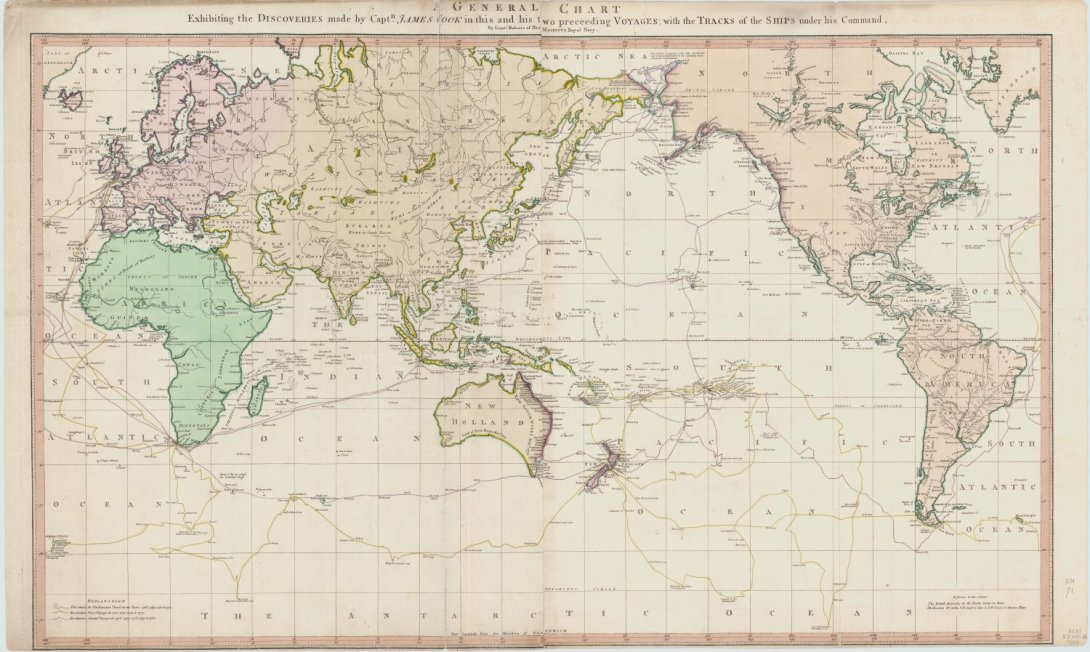
The Library holds a number of objects that allegedly belonged to Cook, such as a walking stick, a clothes brush and a fork. A more substantial artefact is a mahogany and rosewood fall-front desk that was believed to have been used by Cook on one of his voyages. Other association items are a compass, protractor, ruler and spirit level owned by Alexander Hood, the master’s mate on HMS Resolution in 1772–75.
Three of the medals issued by the Royal Society in 1784 to commemorate the achievements of Cook are held in the Library. Another medal issued in 1823 to commemorate his voyages is also held.
The Library has several collections of tapa cloth, including a piece of cloth and two reed maps brought back by Alexander Hood in 1774 and a catalogue of 56 specimens of cloth collected on Cook’s three voyages (1787).
Captain James Cook's walking stick
Clothes brush said to have been the property of Captain Cook
Captain James Cook's fork
Mahogany fall-front bureau believed to have been used by Captain Cook
Compass, protractor, ruler and spirit level owned by Alexander Hood
Commemorative medal to celebrate the voyages of Captain James Cook (1784)
Medal to commemorate the voyages of Captain Cook (1823)
Sample of tapa cloth and two reed mats brought back by Alex Hood
A catalogue of the different specimens of cloth collected in the three voyages of Captain Cook
The Library holds a very large number of engraved portraits of James Cook, many of them based on the paintings by Nathaniel Dance, William Hodges and John Webber. It also holds two oil portraits by unknown artists, one being a copy of the portrait by Dance held in the National Maritime Museum in London. Of special interest is a large oil painting by John Mortimer, possibly painted in 1771, depicting Daniel Solander, Joseph Banks, James Cook, John Hawkesworth and Lord Sandwich.
There were two artists on the Endeavour : Alexander Buchan, who died in Tahiti in 1769, and Sydney Parkinson, who died in Batavia in 1771. The Library has a few original works that have been attributed to Parkinson, in particular a watercolour of breadfruit, which is in the Nan Kivell Collection. In addition, there are a number of prints that were reproduced in the publications of Hawkesworth and Parkinson in 1773, including the interior of a Tahitian house, the fort at Point Venus, a view of Matavai Bay, Maori warriors and war canoes, mountainous country on the west coast of New Zealand, and a view of Endeavour River.
William Hodges was the artist on the Resolution in 1772–75. The Library holds an outstanding collection of 18 chalk drawings by Hodges of the heads of Pacific Islanders. They depict men and women of New Zealand, Tahiti, Tonga, New Caledonia, New Hebrides and Easter Island. Other works by Hodges include an oil painting of a dodo and a red parakeet, watercolours of Tahiti, Tonga and the New Hebrides, and an oil painting of Point Venus. There are also two pen and wash drawings of the Resolution by John Elliott, who was a midshipman on the ship. Among the prints of Hodges are other heads of Pacific Islanders, a portrait of Omai, the Tahitian who visited England in 1775–76, and views of Tahiti, New Caledonia, New Hebrides, Norfolk Island, Easter Island and Tierra del Fuego.
John Webber, who was on the Resolution in 1776–80, had been trained as a landscape artist in Berne and Paris. Another artist on the expedition was William Ellis, the surgeon’s mate on the Discovery , who was a fine draughtsman. The Library holds 19 of Webber’s watercolours, ink and wash drawings, crayon drawings and pencil drawings of views in Tahiti, the Friendly Islands, the Sandwich Islands, Alaska and Kamchatka. There are also oil portraits by Webber of John Gore and James King. Ellis is equally well represented, with 23 watercolours, ink drawings and pencil drawings of scenes in Kerguelen Island, New Zealand, Tahiti, Nootka Sound, Alaska and Kamchatka. Of particular interest is a watercolour and ink drawing by Ellis of the Resolution and Discovery moored in Adventure Bay in 1777, the earliest original Australian work in the Pictures Collection. The death of Cook is the subject of the largest oil painting in the Library’s collection, painted by George Carter in 1781.
Omai, the first Polynesian to be seen in London, was the subject of a number of portraits, included a celebrated painting by Sir Joshua Reynolds. The Library has a pencil drawing of Omai by Reynolds. A pantomime by John O’Keefe entitled Omai, or a Trip Round the World , enjoyed great success in London in 1785–86, being played more than 50 times. The Library holds a collection of 17 watercolour costume designs for the pantomime, drawn by Philippe de Loutherbourg and based mainly on drawings by Webber. The subjects include ‘Obereyaee enchatress’, ‘Otoo King of Otaheite’, ‘a chief of Tchutzki’ and ‘a Kamtchadale’.
Publications
Bibliography.
Beddie,M.K. (ed.), Bibliography of Captain James Cook, R,N., F.R.S., circumnavigator , Library of New South Wales, Sydney, 1970.
Original Accounts of the Voyages
Hawkesworth, John, An account of the voyages undertaken by the order of His Present Majesty, for making discoveries in the Southern Hemisphere, and successively performed by Commodore Byron, Captain Wallis, Captain Carteret, and Captain Cook, in the Dolphin, the Swallow, and the Endeavour (3 vols, 1773)
Parkinson, Sydney, A journal of the voyage to the South Seas, in His Majesty’s Ship, the Endeavour (1773)
Marra, John, Journal of the Resolution’s Voyage, in 1772, 1773, 1774, and 1775, on Discovery to the Southern Hemisphere (1775)
Cook, James, A voyage towards the South Pole, and round the world: performed in His Majesty’s Ships the Resolution and the Adventure in the years 1772,1773, 1774, and 1775 (2 vols, 1777)
Forster, Georg, A voyage round the world in His Britannic Majesty’s Sloop, Resolution, Commanded by Capt. James Cook, during the years 1772, 3, 4 and 5 (2 vols, 1777)
Wales, William, The original astronomical observations, made in the course of a voyage towards the South Pole, and round the world (1777)
Rickman, John, Journal of Captain Cook’s last voyage to the Pacific Ocean, on discovery: performed in the years 1776, 1777, 1778, and 1779 (1781)
Zimmermann, Heinrich, Heinrich Zimmermanns von Wissloch in der Pfalz, Reise um die Welt, mit Capitain Cook (1781)
Ellis, William, An authentic narrative of a voyage performed by Captain Cook and Captain Clerke, in His Majesty’s ships Resolution and Discovery during the years 1776, 1777, 1778, 1779, and 1780 (2 vols, 1782)
Ledyard, John, Journal of Captain Cook’s last voyage to the Pacific Ocean, and in quest of a North-West Passage Between Asia & America, performed in the years 1776, 1777, 1778 and 1779 (1783)
Cook, James and King, James, A voyage to the Pacific Ocean: undertaken by Command of His Majesty, for making discoveries in the Northern Hemisphere, performed under the direction of Captains Cook, Clerke, and Gore, in the years 1776, 1777, 1778, 1779, and 1780 (4 vols, 1784)
Sparrman, Anders, Reise nach dem Vorgebirge der guten Hoffnung, den sudlischen Polarlandern und um die Welt (1784)
Modern Texts
Beaglehole, J.C. (ed.), The Endeavour journal of Joseph Banks, 1768–1771 (2 vols, 1962)
Beaglehole, J.C. (ed.), The journals of Captain James Cook on his voyages of discovery (4 vols, 1955–74)
David, Andrew (ed.), The charts & coastal Views of Captain Cook’s voyages (3 vols, 1988–97)
Hooper, Beverley (ed.), With Captain James Cook in the Antarctic and Pacific: the private journal of James Burney, Second Lieutenant on the Adventure on Cook’s second voyage, 1772–1773 (1975)
Joppien, Rudiger and Smith, Bernard, The art of Captain Cook’s voyages (3 vols in 4, 1985–87)
Parkin, Ray, H.M. Bark Endeavour: her place in Australian history: with an account of her construction, crew and equipment and a narrative of her voyage on the East Coast of New Holland in 1770 (1997)
Biographical Works and Related Studies
There are a huge number of books and pamphlets on the lives of Cook, Banks and their associates. The following are some of the more substantial works:
Alexander, Michael, Omai, noble savage (1977)
Beaglehole, J.C., The life of Captain James Cook (1974)
Besant, Walter, Captain Cook (1890)
Blainey, Geoffrey, Sea of dangers: Captain Cook and his rivals (2008)
Cameron, Hector, Sir Joseph Banks, K.B., P.R.S.: the autocrat of the philosophers (1952)
Carr, D.J., Sydney Parkinson, artist of Cook’s Endeavour voyage (1983)
Carter, Harold B., Sir Joseph Banks, 1743–1820 (1988)
Collingridge, Vanessa, Captain Cook: obsession and betrayal in the New World (2002)
Connaughton, Richard, Omai, the Prince who never was (2005)
Dugard, Martin, Farther than any man: the rise and fall of Captain James Cook (2001)
Duyker, Edward, Nature’s argonaut: Daniel Solander 1733–1782: naturalist and voyager with Cook and Banks (1998)
Furneaux, Rupert, Tobias Furneaux, circumnavigator (1960)
Gascoigne, John, Captain Cook: voyager between worlds (2007)
Hoare, Michael E., The tactless philosopher: Johann Reinhold Forster (1729–98) (1976)
Hough, Richard, Captain James Cook: a biography (1994)
Kippis, Andrew, The life of Captain James Cook (1788)
Kitson, Arthur, Captain James Cook, RN, FRS, the circumnavigator (1907)
Lyte, Charles, Sir Joseph Banks: 18th Century explorer, botanist and entrepreneur (1980)
McAleer, John and Rigby, Nigel, Captain Cook and the Pacific: art, exploration & empire (2017)
McCormick, E.H., Omai: Pacific envoy (1977)
McLynn, Frank, Captain Cook: master of the seas (2011)
Molony, John N., Captain James Cook: claiming the Great South Land (2016)
Moore, Peter, Endeavour: the ship and the attitude that changed the world (2018)
Mundle, Rob, Cook (2013)
Nugent, Maria, Captain Cook was here (2009)
Obeyesekere, Gananath, The apotheosis of Captain Cook: European mythmaking in the Pacific (1992)
O’Brian, Patrick, Joseph Banks, a life (1987)
Rienits, Rex and Rienits, Thea, The voyages of Captain Cook , 1968)
Robson, John, Captain Cook's war and peace: the Royal Navy years 1755-1768 (2009)
Sahlins, Marshall, How ‘natives’ think: about Captain Cook, for example (1995)
Saine, Thomas P., Georg Forster (1972)
Smith, Edward, The life of Sir Joseph Banks, president of the Royal Society (1911)
Thomas, Nicholas, Cook: The extraordinary voyages of Captain James Cook (2003)
Villiers, Alan, Captain Cook, the seamen’s seaman: a study of the great discoverer (1967).
Organisation
The manuscripts of Cook and his associates are held in the Manuscripts Collection at various locations. They have been catalogued individually. Some of them have been microfilmed, such as the Endeavour journal (mfm G27412), the Endeavour log and letterbook (mfm G3921) and the Resolution letterbook (mfm G3758). The Endeavour journal and letterbook and the papers of Sir Joseph Banks have been digitised and are accessible on the Library’s website. The microfilms have also been catalogued individually and are accessible in the Newspaper and Microcopy Reading Room.
The paintings, drawings, prints and objects are held in the Pictures Collection, while the maps and published coastal views are held in the Maps Collection. They have been catalogued individually and many of them have been digitised.
Biskup, Peter, Captain Cook’s Endeavour Journal and Australian Libraries: A Study in Institutional One-upmanship , Australian Academic and Research Libraries , vol. 18 (3), September 1987, pp. 137–49.
Cook & Omai: The Cult of the South Seas , National Library of Australia, Canberra, 2001.
Dening, Greg, MS 1 Cook, J. Holograph Journal , in Cochrane, Peter (ed.), Remarkable Occurrences: The National Library of Australia’s First 100 Years 1901–2001 , National Library of Australia, Canberra, 2001.
Healy, Annette, The Endeavour Journal 1768–71 , National Library of Australia, Canberra, 1997.
Healy, Annette, ' Charting the voyager of the Endeavour journal ', National Library of Australia News, volume 7(3), December 1996, pp 9-12
Hetherington, Michelle, 'John Hamilton Mortimer and the discovery of Captain Cook', British Art Journal, volume 4 (1), 2003, pp. 69-77
First posted 2008 (revised 2019)
The National Library of Australia acknowledges Australia’s First Nations Peoples – the First Australians – as the Traditional Owners and Custodians of this land and gives respect to the Elders – past and present – and through them to all Australian Aboriginal and Torres Strait Islander people.
Cultural Notification
Australian Aboriginal and Torres Strait Islander people are advised that this website contains a range of material which may be considered culturally sensitive including the records of people who have passed away.

Captain Cook’s voyages of exploration
Terra Australis Incognita - the unknown southern land. The existence (or not) of this mysterious, mythical place has intrigued philosophers, explorers and map-makers since it was first hypothesised by the ancient Greeks and Romans. The empire-builders of 18th century Britain were just as obsessed with investigating territories below the Equator.
In 1768, when Captain James Cook set sail on the first of three voyages to the South Seas, he carried with him secret orders from the British Admiralty to seek ‘a Continent or Land of great extent’ and to take possession of that country ‘in the Name of the King of Great Britain’.
While each of Cook's three epic journeys had their own aims and significant achievements, it was this confidential agenda that would transform the way Europeans engaged with the Pacific, its lands and inhabitants. The maps, journals, log books and paintings from Cook’s travels are just some of the State Library’s incredible records of this exciting time.
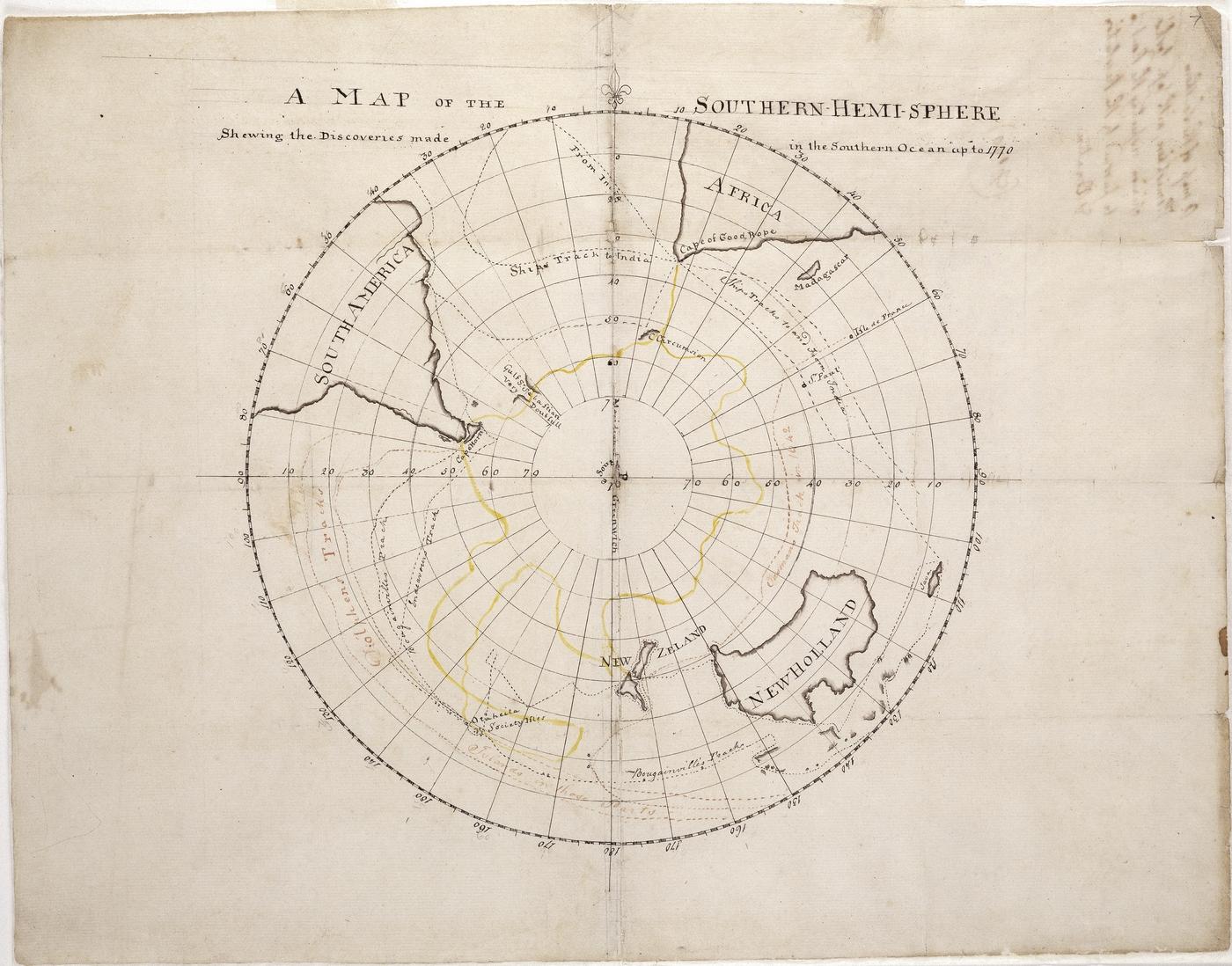
The first voyage
James Cook's first Pacific voyage (1768-1771) was aboard the Endeavour and began on 27 May 1768. Cook’s voyage had three aims; to establish an observatory at Tahiti in order to record the transit of Venus (when the planet passed between the earth and the sun), on 3 June 1769. The second aim was to record natural history, led by 25-year-old Joseph Banks. The final secret goal was to continue the search for the Great South Land.
Cook reached the southern coast of New South Wales in 1770 and sailed north, charting Australia’s eastern coastline and claiming the land for Great Britain on 22nd August 1770.
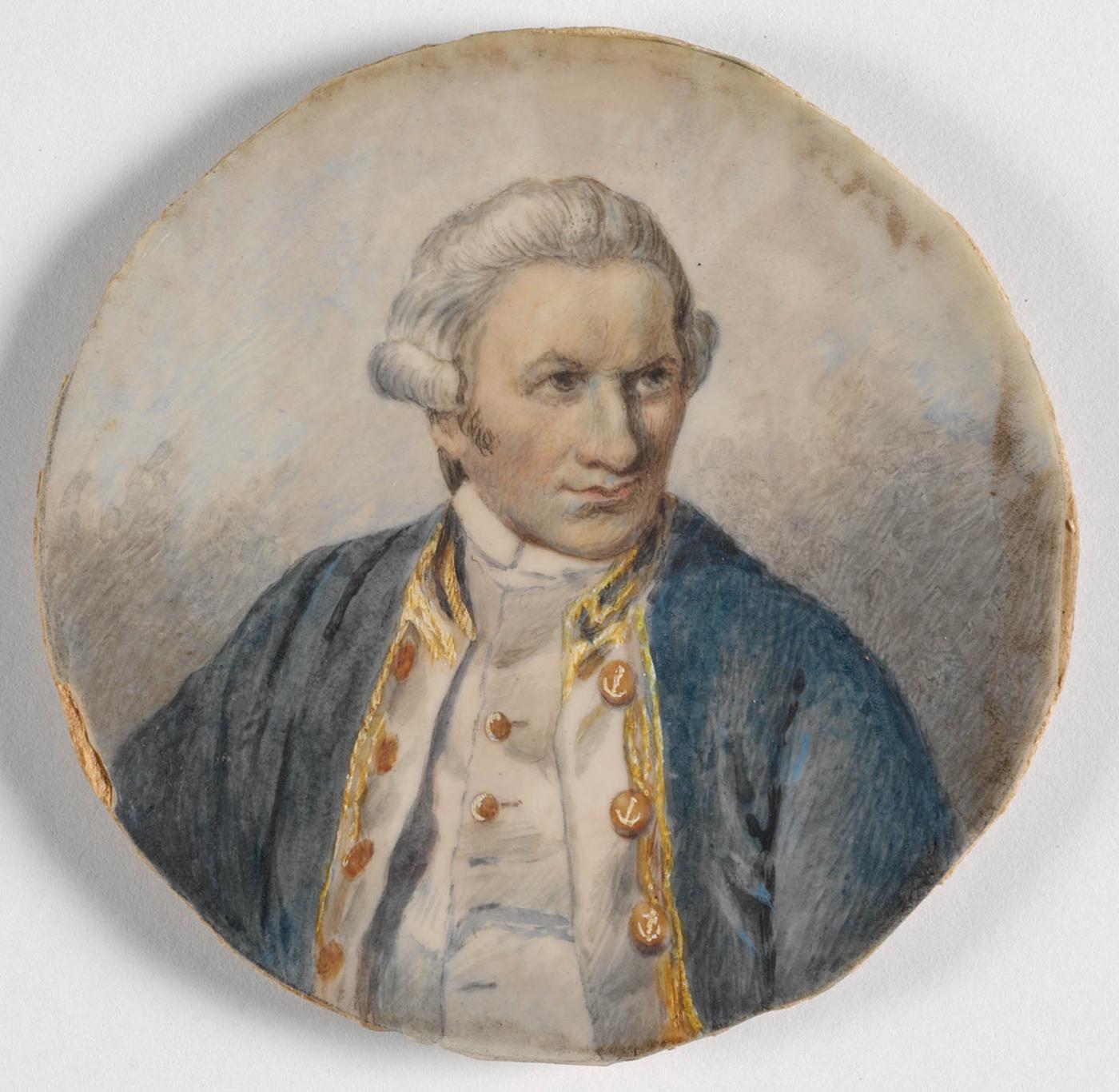
The second voyage
Cook's second Pacific voyage, (1772-1775), aimed to establish whether there was an inhabited southern continent, and make astronomical observations.
The two ships Resolution and Adventure were fitted out for the expedition. In 1772, before he set out, Cook created a map which showed the discoveries made in the Southern Ocean up until 1770 and sketched out his proposed route for the upcoming voyage. In 1773, accompanied by naturalists, astronomers and an artist, Cook made his first crossing of the Antarctic Circle, claiming that he had been further south than any person. During a voyage of 100,000 km, Cook sailed south of the Antarctic Circle (at 66˚30’S) on three occasions, proving that the southern landmass was neither as large or as habitable as once thought. Cook also discovered several islands along the Scotia Arc, initiating the commercial interest that underpinned much of the focus on Antarctica over the next 150 years.
The third voyage
Cook’s third and final voyage (1776-1779) of discovery was an attempt to locate a North-West Passage, an ice-free sea route which linked the Atlantic to the Pacific Ocean. Again, Cook commanded the Resolution while Charles Clerke commanded Discovery . Leaving England in 1776, Cook first sailed south to Tahiti to return Omai, a Tahitian man, to his home. Omai had been taken on Cook’s second voyage and had been an object of curiosity in London. It was on this, Cook's final voyage, that he discovered the Hawaiian Islands in January 1778. This major discovery would lead to his death – Cook was killed on a return visit to Hawaii at Kealakekua Bay, on 14 February 1779.
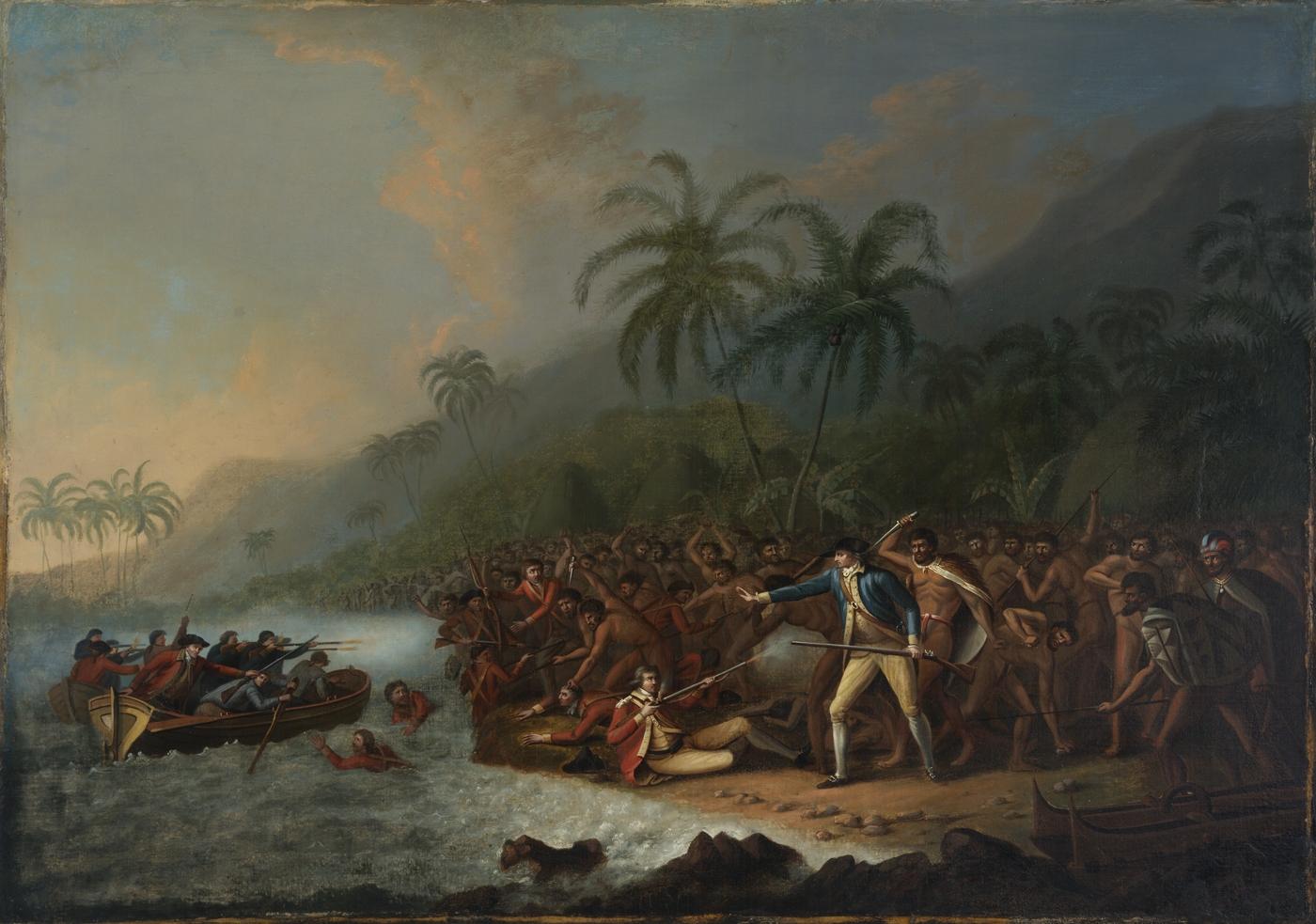
This story has been developed with the support of the State Library of NSW Foundation.
We would like to acknowledge the generosity of the Bruce and Joy Reid Foundation.
- Exploration
Story chapters
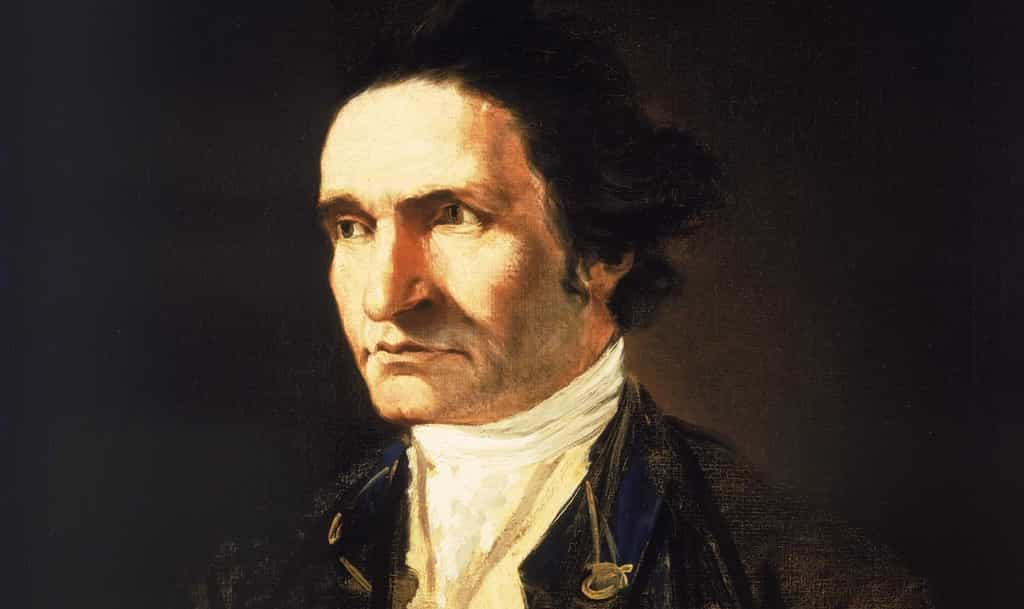
Histoire : James Cook l'explorateur du Pacifique
Époque moderne
question réponse
Courageux, leader ambitieux et humaniste dans l’âme, doté d’un grand sens marin, doué pour la cartographie, James Cook incarne l’idée de l’explorateur au XVIII e siècle bravant et dépassant les limites. Le récit des observations de ce capitaine de la Royal Navy fut précieux pour enrichir les connaissances sur l'océan Pacifique.
au sommaire
Au XVIII e siècle, le grand navigateur navigateur explorateur est certainement incarné par l'Anglais James Cook (1728-1779) : cartographe et hydrographe, il débute sa carrière dans la marine royale britannique en 1755. Pendant la guerre de Sept Ans et le siège de Québec , il cartographie l'embouchure du Saint-Laurent, Terre-Neuve et les côtes du Labrador.
Nommé commandant de l' Endeavour Endeavour en 1768, il va acquérir un prestige considérable en se consacrant à trois expéditions successives dans l'océan Pacifique, au cours desquelles il effectue le tour complet de la Nouvelle Zélande, explore la côte est de l'Australie, tente d'approcher le continent antarctique antarctique , étudie l'île de Pâques et découvre les îles Hawaï.
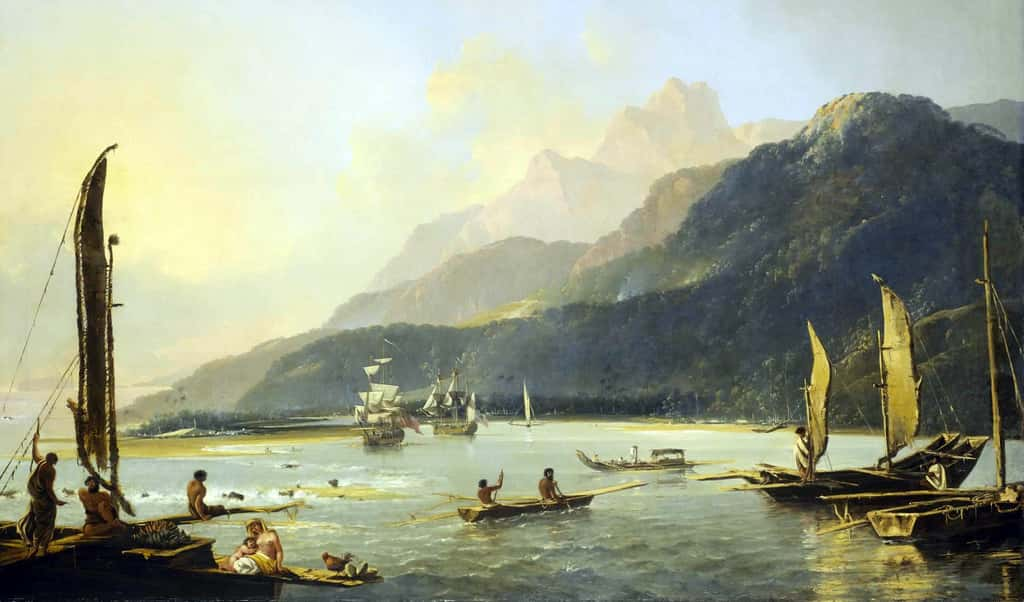
Premier voyage (1768-1771)
Commandité par la Royal Society de Londres, le premier voyage de James Cook a pour but d'observer à Tahiti , le passage de la planète Vénus Vénus sur le disque du Soleil, phénomène très rare prévu pour le 3 juin 1769. Parti de Plymouth en août 1768, le navire Endeavour traverse l'Atlantique, passe le Cap Horn et atteint Tahiti en avril 1769. Cook y fait construire un observatoire dans le but de recueillir des mesures permettant de déterminer avec précision la distance séparant Vénus du Soleil.
Les instructions pour la seconde partie de son voyage concernent la recherche de la mythique Terra Australis inconnue (le continent Antarctique). La Royal Society est persuadée de son existence et la couronne britannique espère y faire flotter l'Union Jack ! En septembre 1769, l'expédition atteint la Nouvelle Zélande : James Cook est le deuxième explorateur à visiter l'île après sa découverte par Abel Tasman en 1642. Il en établit une carte exceptionnellement précise, qui montre qu'elle comprend deux îles séparées par un détroit qui porte porte aujourd'hui son nom.
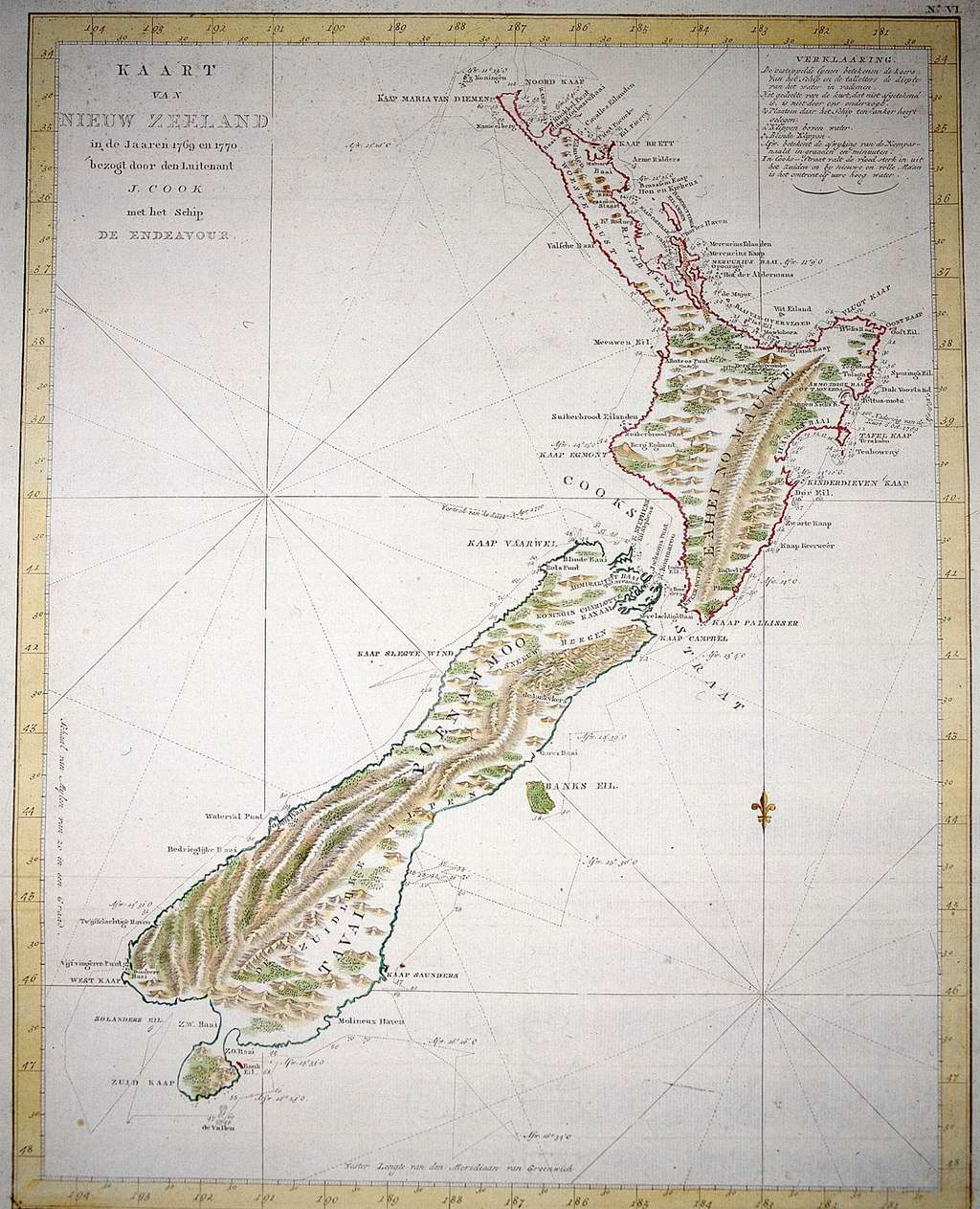
Sur le chemin du retour, il explore la côte orientale de la Nouvelle Hollande (Australie) où les scientifiques anglais découvrent les kangourous kangourous et une grande quantité d' espèces espèces animales nouvelles, dans une baie baptisée Botany Bay . La Grande Bretagne choisira ce site pour y établir la première colonie britannique d'Australie. En poursuivant vers le nord, le long de la côte australienne, l'Endeavour évite de justesse un naufrage sur la Grande Barrière de corail , en juin 1770.
Après sept semaines de réparation à l'embouchure de l' Endeavour River , le navire prend la route maritime de l'Ouest et entre dans le port de Batavia (Indonésie), siège de la Compagnie des Indes orientales néerlandaises, en octobre 1770. Puis, il double le Cap de Bonne Espérance en mars 1771 et rejoint l'Angleterre en juin. La publication du journal de l'expédition rend James Cook très populaire au sein de la communauté scientifique britannique.

Deuxième voyage (1772-1775)
Très satisfaite des conclusions de la première expédition, la Royal Society demande à Cook de se rendre à nouveau dans le Pacifique , à la recherche du continent austral. Le deuxième voyage va détruire pour un temps le mythe de la terre australe inconnue. Deux navires participent à l'expédition : le Resolution et l' Adventure . L'acquisition d'un nouveau chronomètre chronomètre de marine va permettre le calcul précis de la longitude longitude .
Le cercle polaire cercle polaire antarctique est franchi le 17 janvier 1773 et la latitude latitude de 71°10' (sud) est atteinte. Les deux bateaux se perdent de vue dans le brouillard brouillard de l’Antarctique et l' Adventure met le cap sur la Nouvelle-Zélande, avant de repartir pour la Grande Bretagne. Cook poursuit son exploration de la zone Antarctique et frôle le continent sans l'apercevoir ; personne n'est encore jamais allé aussi loin vers le sud.
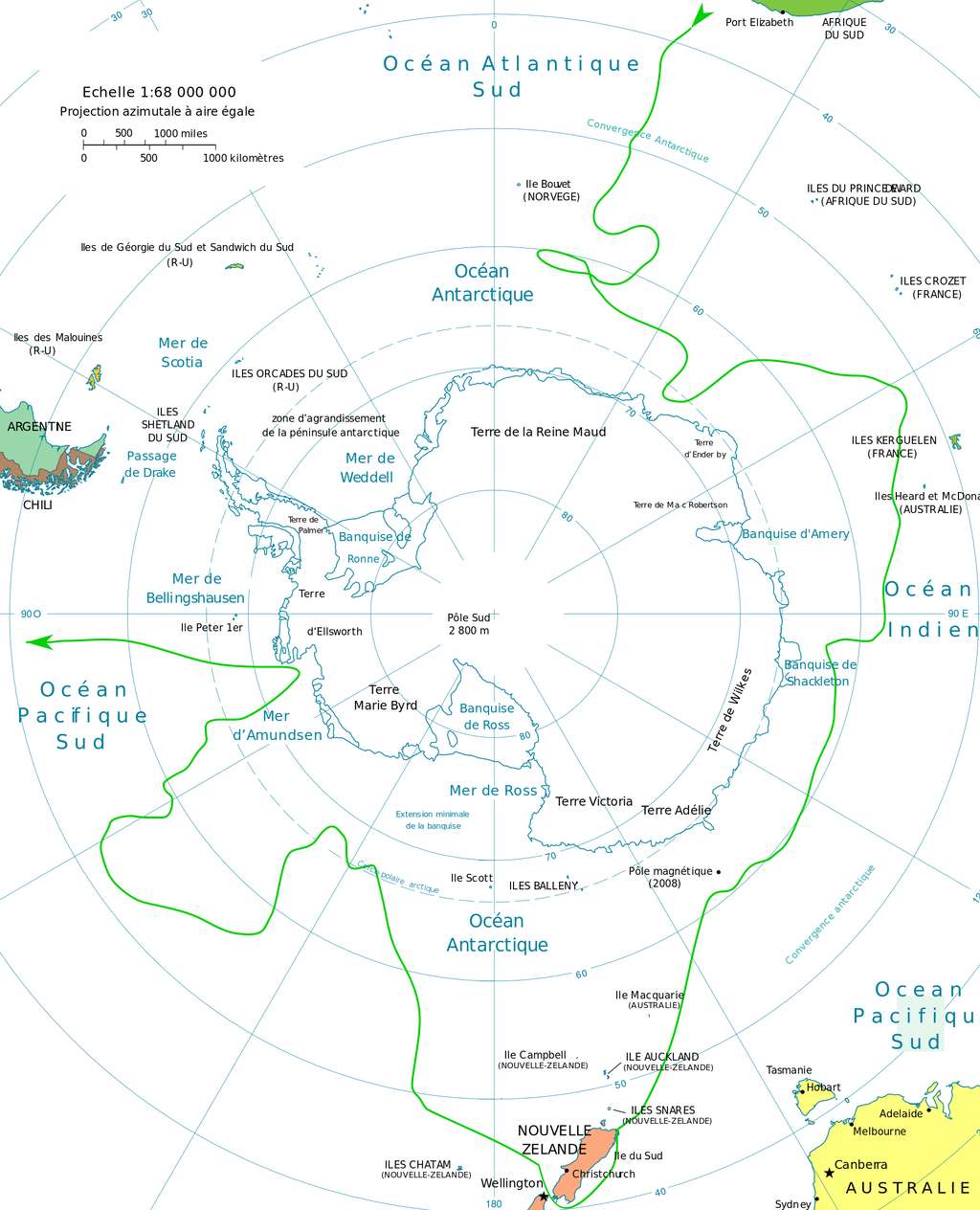
Cook en conclut que la grande terre australe tant recherchée n'existe pas. Sur le chemin du retour, il effectue une halte à l’île de Pâques (Rapa Nui), découverte par le navigateur hollandais Jakob Roggeveen, le dimanche de Pâques 1722. Cook est le premier à tenter de percer l'énigme des statues gigantesques : son séjour sur l'île en mars 1774, fournit des informations essentielles sur la constitution géologique, la végétation, la population et pose de nombreuses questions sur les statues déjà renversées par les Hommes ou par un séisme séisme .

Troisième voyage (1776-1779)
Pour son troisième voyage, James Cook tente de trouver le passage du nord-ouest entre Atlantique et Pacifique. L'expédition comprend encore deux navires : le Resolution et le Discovery Discovery . L'exploration commence par les îles Kerguelen à Noël 1776, et se poursuit par un détour en Nouvelle Zélande. Puis, Cook met le cap au Nord, découvre l'île Christmas à Noël 1777 (Kiribati, Pacifique nord) et accoste aux îles Hawaï (ou îles Sandwich) en 1778.
Les navires suivent les côtes du continent américain : dans son journal, James Cook décrit les tribus indiennes de Vancouver, les côtes d'Alaska, les îles Aléoutiennes et les rives du détroit de Béring . Après plusieurs tentatives, le détroit de Béring reste infranchissable en raison des glaces qui l'obstruent même en plein mois d'août.

Une escale fatale aux îles Sandwich en février 1779, met fin à la vie du grand navigateur : une altercation éclate avec les habitants, Cook est frappé à la tête, battu puis, les Hawaïens enlèvent son corps. Des hypothèses controversées font état d'une possible consommation humaine ; l'équipage récupère les restes de leur capitaine pour l'inhumer en mer avec les honneurs militaires.
C'est James Cook lui-même qui a baptisé les îles « Sandwich » en l'honneur d'un comte anglais du même nom ! Il n'est certainement pas le premier Européen à y poser le pied : en effet durant le XVI e siècle, des navigateurs espagnols, néerlandais et portugais sillonnent déjà le Pacifique. Les îles Hawaï sont peut-être découvertes en 1527 par des navigateurs espagnols envoyés par Cortés .

James Cook a consacré plus de dix années à naviguer dans l'océan Pacifique et ses voyages ont apporté énormément de connaissances sur cette région du globe aux Européens. Il a découvert plusieurs îles, cartographié d'immenses portions de côtes, permis le calcul précis de la longitude. L'une des conséquences des explorations de Cook est la colonisation de l'Australie par la Couronne britannique et l'installation d'un lieu de déportation à Botany Bay . En 1788, les premiers déportés vont y croiser le Français, Jean-François de La Pérouse , et son équipage. Ils seront aussi les derniers à le voir vivant.
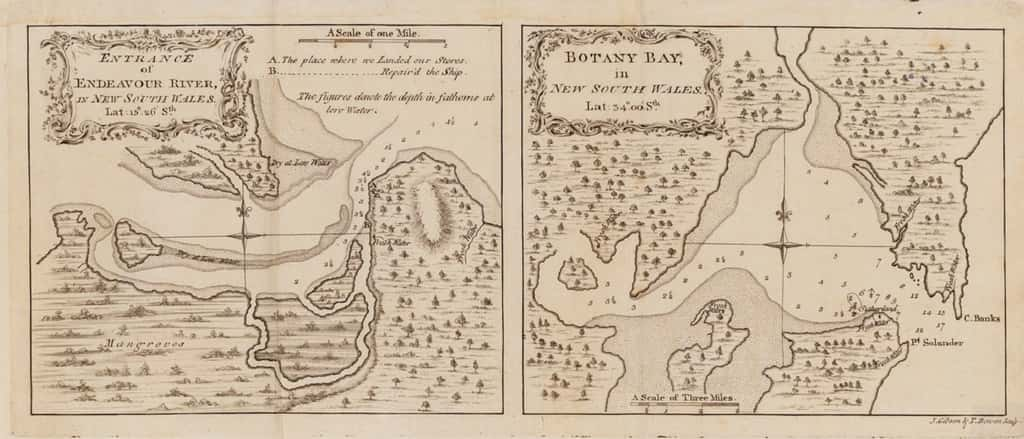
par Isabelle Bernier
le 30 mai 2019
Nos articles
à lire aussi

Histoire des Indiennes, ces tissus très à la mode au XVIIIe siècle
• 25/10/2018

La découverte de l’Australie et le mythe de la Terre australe inconnue
• 27/09/2018
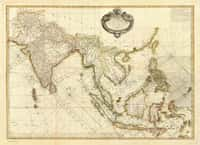
Joseph-François Dupleix ou le rêve d'un empire français en Inde
• 11/10/2018

Cassini : la grande aventure de la Carte de France au XVIIIe siècle
• 18/10/2018

Archéologie
Archéologie lyonnaise au XVIIIe siècle, l'expertise d'un céramologue
• 22/08/2022

Philosophie
Sciences, sectes et religion
• 30/01/2003
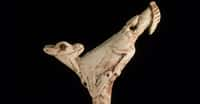
Préhistoire
Epoque Magdalénienne : Le mythe du faon à l'oiseau
• 17/09/2003
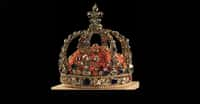
De François Ier à Louis XVI, le fonctionnement de la monarchie absolue en France
• 29/06/2023
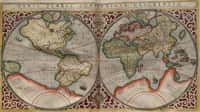
Histoire de la route des Indes : une épopée maritime
• 12/07/2018

La France au XVIIIe siècle est un géant démographique
• 06/09/2018
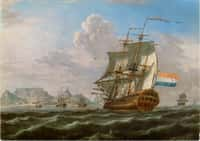
Pourquoi a-t-on créé les Compagnies des Indes ?
• 17/06/2018

Histoire : la naissance de la marine royale en France
• 24/01/2019
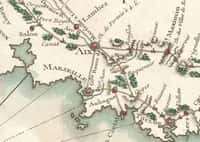
À quoi ressemblait le réseau routier français au XVIIIe siècle ?
• 04/10/2018
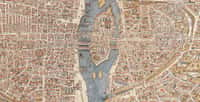
Histoire : le territoire du royaume de France au XVIe siècle
• 21/03/2019

Les îles Cook créent un sanctuaire de requins grand comme le Mexique
• 20/12/2012
Transmettre la culture
est le plus vieux métier du monde
Inscrivez-vous à la lettre d'information La quotidienne pour recevoir toutes nos dernières Actualités une fois par jour.
À voir aussi
james staunton
explorateur windows
explorateur linux
télescope james webb
james dewey watson
gaia age james cameron
biographie james watt
james clerk maxwell
telescope james webb
XVIIIe siècle
Grandes explorations
Explorateur
Fin du XVIIIe siècle au Royaume-Uni
Cartographie
Cartographie marine
Les grands navigateurs
Grandes expéditions
Exploration des mers
François de La Pérouse
Île de Pâques
Continent Austral
Cap de Bonne espérance
Compagnie des Indes orientales
Terra australis
Côtes du Labrador
Histoires d'Îles
Marine royale
Définitions associées
- Qu'est-ce que "soleil" signifie ?
Find anything you save across the site in your account
How Captain James Cook Got Away with Murder
By Elizabeth Kolbert

On Valentine’s Day, 1779, Captain James Cook invited Hawaii’s King Kalani‘ōpu‘u to visit his ship, the Resolution. Cook and the King were on friendly terms, but, on this particular day, Cook planned to take Kalani‘ōpu‘u hostage. Some of the King’s subjects had stolen a small boat from Cook’s fleet, and the captain intended to hold Kalani‘ōpu‘u until it was returned. The plan quickly went awry, however, and Cook ended up face down in a tidal pool.
At the time of his death, Cook was Britain’s most celebrated explorer. In the course of three epic voyages—the last one, admittedly, unfinished—he had mapped the east coast of Australia, circumnavigated New Zealand, made the first documented crossing of the Antarctic Circle, “discovered” the Hawaiian Islands, paid the first known visit to South Georgia Island, and attached names to places as varied as New Caledonia and Bristol Bay. Wherever Cook went, he claimed land for the Crown. When King George III learned of Cook’s demise, he reportedly wept. An obituary that ran in the London Gazette mourned an “irreparable Loss to the Public.” A popular poet named Anna Seward published an elegy in which the Muses, apprised of Cook’s passing, shed “drops of Pity’s holy dew.” (The work sold briskly and was often reprinted without the poet’s permission.)
“While on each wind of heav’n his fame shall rise, / In endless incense to the smiling skies,” Seward wrote. Artists competed to depict Cook’s final moments; in their paintings and engravings, they, too, tended to represent the captain Heaven-bound. An account of Cook’s life which ran in a London magazine declared that he had “discovered more countries in the Atlantic and Pacific Oceans than all the other navigators together.” The anonymous author of this account opined that, among mariners, none would be “more entitled to the admiration and gratitude of posterity.”
The Best Books of 2024
Read our reviews of the year’s notable new fiction and nonfiction.
Posterity, of course, has a mind of its own. In 2019, the two-hundred-and-fiftieth anniversary of Cook’s landing in New Zealand, a replica of the ship he’d sailed made an official tour around the country. According to New Zealand’s government, the tour was intended as an opportunity to reflect on the nation’s complex history. Some Māori groups banned the boat from their docks, on the ground that they’d already reflected enough.
Cook “was a barbarian,” the then chief executive of the Ngāti Kahu iwi told a reporter. Two years ago, an obelisk erected in 1874 to mark the spot where Cook was killed, on Kealakekua Bay, was vandalized. “You are on native land,” someone painted on the monument. In January, on the eve of Australia Day, an antipodean version of the Fourth of July, a bronze statue of Cook that had stood in Melbourne for more than a century was sawed off at the ankles. When a member of the community council proposed that area residents be consulted on whether to restore the statue, a furor erupted. At a meeting delayed by protest, the council narrowly voted against consultation and in favor of repair. A council member on the losing side expressed shock at the way the debate had played out, saying it had devolved into an “absolutely crazy mess.”
Into these roiling waters wades “ The Wide Wide Sea: Imperial Ambition, First Contact and the Fateful Final Voyage of Captain James Cook ” (Doubleday), a new biography by Hampton Sides. Sides, a journalist whose previous books include the best-selling “ Ghost Soldiers ,” about a 1945 mission to rescue Allied prisoners of war, acknowledges the hazards of the enterprise. “Eurocentrism, patriarchy, entitlement, toxic masculinity,” and “cultural appropriation” are, he writes, just a few of the charged issues raised by Cook’s legacy. It’s precisely the risks, Sides adds, that drew him to the subject.
Cook, the second of eight children, was born in 1728 in Yorkshire. His father was a farm laborer, and Cook would likely have followed the same path had he not shown early promise in school. His parents apprenticed him to a merchant, but Cook was bored by dry goods. In 1747, he joined the crew of the Freelove, a boat that, despite its name, was designed for the distinctly unerotic task of ferrying coal to London.
After working his way up in the Merchant Navy, Cook jumped ship, as it were. At the age of twenty-six, he enlisted in the Royal Navy, and one of his commanders, recognizing Cook’s talents, encouraged him to take up surveying. A chart that Cook helped draft of the St. Lawrence River proved crucial to the British victory in the French and Indian War.
In 1768, Cook was given command of his own ship, H.M.S. Endeavour, a boxy, square-sterned boat that, like the Freelove, had been built for hauling coal. The Navy was sending the Endeavour to the South Pacific, ostensibly for scientific purposes. A transit of Venus was approaching, and it was believed that careful observation of the event could be used to determine the distance between the Earth and the sun. Cook and his men were supposed to watch the transit from Tahiti, which the British had recently claimed. Then, and only then, was the captain to open a set of sealed orders from the Admiralty which would provide further instructions.
The Endeavour departed from Plymouth, made its way to Rio, and from there sailed around the tip of South America. Arriving in Tahiti, where British and French sailors had already infected many of the women with syphilis, Cook drew up rules to govern his crew’s dealings with the island’s inhabitants. The men were not to trade items from the boat “in exchange for any thing but provisions.” (That rule appears to have been flagrantly flouted.)
The day of the transit—June 3, 1769—dawned clear, or, as Cook put it, “as favourable to our purposes as we could wish.” But the observers’ measurements differed so much that it was evident—or should have been—that something had gone wrong. (The whole plan, it later became clear, was fundamentally flawed.) Whether Cook had indeed waited until this point to open his secret instructions is unknown; in any event, they pointed to the true purpose of the trip. From Tahiti, the Endeavour was to seek out a great continent—Terra Australis Incognita—theorized to lie somewhere to the south. If Cook located this continent, he was to track its coast, and “with the Consent of the Natives to take possession of Convenient Situations in the Country in the Name of the King of Great Britain.” If he didn’t locate it, he was to head to New Zealand, which the British knew of only vaguely, from the Dutch.
The Endeavour spent several weeks searching for the continent. Nothing much happened during this period except that a crew member drank himself to death. As per the Admiralty’s instructions, Cook next headed west. The ship landed on the east coast of New Zealand’s North Island on October 8, 1769. Within the first day, Cook’s men had killed at least four Māori and wounded several others.
A ship like the Endeavour was its own floating world, its commander an absolute ruler. A Royal Navy captain was described as a “King at Sea” and could mete out punishment—typically flogging—as he saw fit. At the same time, in the vastness of the ocean, a ship’s captain had no one to turn to for help. He had to be ever mindful that he was outnumbered.
Cook was known as a stickler for order. A crew member recorded that Cook once performed an inspection of his men’s hands; those with dirty fingers forfeited the day’s allowance of grog. He seemed to have a sixth sense for the approach of land; another crew member claimed that Cook could intuit it even in the dead of night. Although in the seventeen-seventies no one knew what caused scurvy, Cook insisted that his men eat fresh fruit whenever possible and that they consume sauerkraut, a good source of Vitamin C.
Of Cook’s inner life, few traces remain. When he set off for Tahiti, he had a wife and three children. Before she died, Elizabeth Cook burned her personal papers, including her correspondence with her husband. Letters from Cook that have been preserved mostly read like this one, to the Navy Board: “Please to order his Majesty’s Bark the Endeavour to be supply’d with eight Tonns of Iron Ballast.” Cook left behind voluminous logs and journals; the entries in these, too, are generally bloodless.
“Punished Richard Hutchins, seaman, with 12 lashes for disobeying commands,” he wrote, on April 16, 1769, when the Endeavour was anchored off Tahiti. “Most part of these 24 hours Cloudy, with frequent Showers of Rain,” he observed, from the same spot, on May 25th. The captain, as one of his biographers has put it, had “no natural gift for rhapsody.” Sides writes, “It could be said that he lived during a romantic age of exploration, but he was decidedly not a romantic.”
Still, feelings and opinions do sometimes creep into Cook’s writing. He is by turns charmed and appalled by the novel customs he encounters. A group of Tahitians cook a dog for him; he finds it very tasty and resolves “for the future never to dispise Dog’s flesh.” He sees some islanders eat the lice that they have picked out of their hair and declares this highly “disagreeable.”
Many of the Indigenous people Cook met had never before seen a European. Cook recognized it was in his interest to convince them that he came in friendship; he also saw that, in case persuasion failed, the main advantage he possessed was guns.
In a journal entry devoted to the Endeavour’s first landing in New Zealand, near present-day Gisborne, Cook treats the killing of the Māori as regrettable but justified. The British had attempted to take some Māori men on board their ship to demonstrate that their intentions were peaceful. But this gesture was—understandably—misinterpreted. The Māori hurled their canoe paddles at the British, who responded by firing at them. Cook acknowledges “that most Humane men” will condemn the killings. But, he declares, “I was not to stand still and suffer either myself or those that were with me to be knocked on the head.”
After mapping both New Zealand’s North and South Islands, Cook headed to Australia, then known as New Holland. The Endeavour worked its way to the country’s northernmost point, which Cook named York Cape (and which is now called Cape York). The inhabitants of the coast made it clear that they wanted nothing to do with the British. Cook left gifts onshore, but they remained untouched.
Cook’s response to the Aboriginal Australians is one of the most often cited passages from his journals. In it, he seems to foresee—and regret—the destruction of Indigenous cultures which his own expeditions will facilitate. “From what I have said of the Natives of New Holland they may appear to some to be the most wretched People upon Earth; but in reality they are far more happier than we Europeans,” he writes.
The earth and Sea of their own accord furnishes them with all things necessary for Life. They covet not Magnificient Houses, Household-stuff, etc.; they live in a Warm and fine Climate, and enjoy every wholesome Air. . . . They seem’d to set no Value upon anything we gave them, nor would they ever part with anything of their own for any one Article we could offer them. This, in my opinion, Argues that they think themselves provided with all the necessarys of Life, and that they have no Superfluities.
If Cook’s first voyage failed to turn up the missing continent or to calculate the Earth’s distance from the sun, imperially speaking it was a resounding success: the captain had claimed both New Zealand and the east coast of Australia for Britain. (In neither case had Cook sought or secured the “Consent of the Natives,” but this lapse doesn’t seem to have troubled the Admiralty.) The very next year, Cook was dispatched again, this time in command of two ships, the Resolution and the Adventure. Navy brass continued to insist that Terra Australis Incognita was out there somewhere—presumably farther south than the Endeavour had ventured—and on his second voyage Cook was supposed to keep sailing until he found it. He crossed and recrossed the Antarctic Circle, at one point getting as far as seventy-one degrees south. Conditions on the Southern Ocean were generally terrible—frigid and foggy. Still, there was no sign of a continent. Cook ventured that if there were any land nearer to the pole it would be so hemmed in by ice that it would “never be explored.” (Antarctica would not be sighted for almost fifty years.)
Once more, Cook hadn’t found what he was seeking, but upon his return he was again hailed as a hero. Britain’s leading scientific institution, the Royal Society, granted him its highest honor, the Copley Medal, and the Navy rewarded him with a cushy desk job. The expectation was that he would settle down, enjoy his sinecure, and finally spend some time with his family. Instead, he set out on yet another expedition.

Link copied
“The Wide Wide Sea” focusses almost exclusively on Cook’s third—and for him fatal—voyage. Sides portrays Cook’s decision to undertake it as an act of hubris; the captain, he writes, “could scarcely imagine failure.” The journey got off to an inauspicious start. Cook’s second-in-command, Charles Clerke, was to captain a ship called the Discovery, while Cook, once again, sailed on the Resolution. When both vessels were scheduled to depart, in July, 1776, Clerke was nowhere to be found. (Thanks to the improvidence of a brother, he’d been tossed in debtors’ prison.) Cook set off without him. A few weeks later, the Resolution nearly crashed into one of the Cape Verde Islands, a mishap that Sides sees as a portent. The ship, it turned out, also leaked terribly—another bad sign.
The plan for the third voyage was more or less the inverse of the second’s. Cook’s instructions were to head north and to look not for land but for its absence. The Admiralty wanted him to find a seaway around Canada—the fabled Northwest Passage. Generations of sailors had sought the passage from the Atlantic and been blocked by ice. Cook was to probe from the opposite direction.
The expedition also had a secondary aim involving a Polynesian named Mai. Mai came from the Society Islands, and in 1773 he had talked his way on board the Adventure. Arriving in London the following year, he entranced the British aristocracy. He sat in on sessions of Parliament, learned to hunt grouse, met the King, and, according to Sides, became “something of a card sharp.” But, after two years of entertaining toffs, Mai wanted to go home. It fell to Cook to take him, along with a barnyard’s worth of livestock that King George III was sending as a gift.
Clerke, on the Discovery, finally caught up to Cook in Cape Town, where the Resolution was docked for provisioning and repairs. Together, the two ships sailed away from Africa and stopped off in Tasmania. In February, 1777, they pulled into Queen Charlotte Sound, a long, narrow inlet in the northeast corner of New Zealand’s South Island. There, more trouble awaited.
Cook had visited Queen Charlotte Sound (which he had named) four times before. During his second voyage, it had been the site of a singularly gruesome disaster. Ten of Cook’s men—sailors on the Adventure—had gone ashore to gather provisions. The Māori had slain and, it was said, eaten them.
Cook wasn’t in New Zealand when the slaughter took place; the Adventure and the Resolution had been separated in a fog. But, on his way back to England, he heard rumblings about it from the crew of a Dutch vessel that the Resolution encountered at sea. Cook was reluctant to credit the rumors. He wrote that he would withhold judgment on the “Melancholy affair” until he had learned more. “I must however observe in favour of the New Zealanders that I have allways found them of a Brave, Noble, Open and benevolent disposition,” he added.
By the time of the third voyage, Cook knew the stories he’d heard were, broadly speaking, accurate. Why, then, did he return to the scene of the carnage? Sides argues that Cook was still searching for answers. The captain, he writes, thought the massacre “demanded an inquiry and a reckoning, however long overdue.”
In his investigation, Cook was aided by Mai, whose native language was similar to Māori. The sequence of events that Mai helped piece together began with the theft of some bread. The leader of the British crew had reacted to this petty crime by shooting not only the thief but also a second Māori man. In retaliation, the Māori had killed all ten British sailors and chopped up their bodies. Eventually, Cook learned who had led the retaliatory raid—a pugnacious local chief named Kahura. One day, Mai pointed him out to Cook. The following day, the captain invited Kahura on board the Resolution and ushered him down into his private cabin. Instead of shooting Kahura, Cook had his draftsman draw a portrait of him.
Mai found Cook’s conduct unfathomable. “Why do you not kill him?” he cried. Cook’s men, too, were infuriated. They made fun of his forbearance by staging a mock trial. One of the sailors had adopted a Polynesian dog known as a kurī. (The breed is now extinct.) The men accused the dog of cannibalism, found it guilty as charged, then killed and ate it.
Sides doesn’t think that Cook knew about the cannibal burlesque, but the captain, he says, sensed his crew’s disaffection. And this, Sides argues, caused something in Cook to snap. For Cook, he writes, the “visit to Queen Charlotte Sound became a sharp turning point.” It would be the last time that the captain would be accused of leniency.
As evidence of Cook’s changed outlook, Sides relates an incident that occurred eight months after the trial of the dog, this one featuring a pregnant goat. The Resolution had anchored off Moorea, one of the Society Islands, and animals from the ship’s travelling menagerie had been left to graze onshore. One day, a goat went missing. Cook was told that the animal had been taken to a village on the opposite end of the island. With three dozen men, he marched to the village and torched it. (Most of the villagers had fled before he arrived.) The next day, the goat still had not been returned, and the British continued their rampage. Such was the level of destruction, one of Cook’s men noted in his journal, that it “could scarcely be repaired in a century.” Another crew member expressed shock at the captain’s “precipitate proceeding,” which, he said, violated “any principle one can form of justice.”
Having wrecked much of Moorea, Cook couldn’t leave Mai there, so he installed him and his livestock on the nearby island of Huahine. A few years later, Mai died, apparently from a virus introduced by yet another boatload of European sailors.
Cook spent several months searching fruitlessly along the coast of Alaska for the Northwest Passage. But, on the journey north from Huahine, he had stumbled upon something arguably better—the Hawaiian Islands. In January, 1778, the Resolution and the Discovery stopped in Kauai. The following January, they landed at Kealakekua Bay, on the Big Island.
What the Hawaiians thought of the strange men who appeared on strange ships has been much debated in academic circles. (Two prominent anthropologists, Marshall Sahlins, of the University of Chicago, and Gananath Obeyesekere, of Princeton, engaged in a high-profile feud on the subject which spanned decades.) Cook and his men happened to have landed on the Big Island at the height of an important festival. The captain was greeted by thousands of people invoking Lono, a god associated with peace and fertility. According to some scholars, the Hawaiians gathered for the festival saw Cook as the embodiment of Lono. According to others, they saw him as someone playacting Lono, and, according to still others, the whole Cook-as-Lono story is a myth created by Europeans. What Cook himself thought is unknown, because no logs or journal entries from the last few weeks of his life survive. It is possible that he just let his record-keeping slide, and it is also possible that the entries contained compromising information and were destroyed by the Admiralty.
After Cook had been on the Big Island for several days, King Kalani‘ōpu‘u appeared with a fleet of war canoes. (He had, it seems, been off fighting on another island.) At first, Kalani‘ōpu‘u welcomed the British—he presented Cook with a magnificent cloak made of feathers, and he dined several times on the Resolution—then he indicated that it was time for them to go. It’s unclear whether the King’s impatience reflected the religious calendar—the festival associated with Lono had concluded—or more mundane concerns, such as feeding so many hungry sailors, but Cook got the message. The expedition soon departed, only to suffer another mishap. The foremast of the Resolution snapped. There was no way for it to go forward, so both ships made their way back to Kealakekua Bay.
It was while the British were trying to repair the Resolution that someone made off with the small boat and Cook decided to take the King hostage. The captain had often resorted to this tactic to get—or get back—what he wanted; it had usually worked well for him, but never before had he dealt with someone as powerful as Kalani‘ōpu‘u. Cook was leading the King down to the beach—Kalani‘ōpu‘u seems to have been convinced he was being invited for another friendly meal—when warriors started to emerge from the trees. Sides argues that Cook could have saved himself had he simply turned and run, but, as one of his men put it, “he too wrongly thought that the flash of a musket would disperse the whole island.” In the fighting that ensued, Cook, four of his men, and as many as thirty Hawaiians were killed. As was customary on the island, Cook’s body was burned. Some of his singed bones were returned to the British; those that remained in Hawaii, according to Sides, were later paraded around as part of the festival associated with Lono.
Though Sides says he wants to “reckon anew” with Cook, it’s not exactly clear what this would entail at a time when the captain has already been—figuratively, at least—sawed off at the ankles. “The Wide Wide Sea” portrays Cook as a complicated figure, driven by instincts and motives that often seem to have been opaque even to him. Although it’s no hagiography, the book is also not likely to rattle teacups at the Captain Cook Society, members of which receive a quarterly publication devoted entirely to Cook-related topics.
Like all biographies, “The Wide Wide Sea” emphasizes agency. Cook may be an ambivalent, even self-contradictory figure; still, it’s his actions and decisions that drive the narrative forward. But, as Cook himself seemed to have realized, and on occasion lamented, he was but an instrument in a much, much larger scheme. The whole reason the British sent him off to seek Terra Australis Incognita was that they feared a rival power would reach it first. If Cook hadn’t hoisted what he called the “English Colours” on what’s still known as Possession Island, in northern Queensland, it seems fair to assume that another captain would have claimed Australia for England or for some other European nation. Similarly, if Cook’s men hadn’t brought sexually transmitted diseases to the Hawaiian Islands, then sailors from a different ship would have done so. Colonialism and its attendant ills were destined to reach the many paradisaical places Cook visited and mapped, although, without his undeniable navigational skills, that might have taken a few years more. ♦
New Yorker Favorites
Searching for the cause of a catastrophic plane crash .
The man who spent forty-two years at the Beverly Hills Hotel pool .
Gloria Steinem’s life on the feminist frontier .
Where the Amish go on vacation .
How Colonel Sanders built his Kentucky-fried fortune .
What does procrastination tell us about ourselves ?
Fiction by Patricia Highsmith: “The Trouble with Mrs. Blynn, the Trouble with the World”
Sign up for our daily newsletter to receive the best stories from The New Yorker .

Books & Fiction
By signing up, you agree to our User Agreement and Privacy Policy & Cookie Statement . This site is protected by reCAPTCHA and the Google Privacy Policy and Terms of Service apply.

By Nicola Twilley

By James Wood

By James Carroll

By Jon Lee Anderson
Our people, your freight.
Yedaiah has a proven methodology for engaging customers using a collaborative solution development process to understand business needs., to tailor our solution to specifically deliver the objectives for our customer’s global supply chains., our core values:.
Innovative – Open and creative to customer and employee solutions.
Transparent Communication and Collaboration. We communicate openly.
Don’t fix what isn’t broken, unless it provides a road map to increased productivity.
Shared Goal & Initiative Alignment.We accomplish our goals more efficiently.
Our proactive approach to invoice consolidation and freight analysis reports.
We carry your trust.
With a global network and advanced logistics solutions, our air freight services provide., our clients, and what they say., delivered packages.
We strongly support best practice sharing across our operations around the world.
Countries Covered
As one of the world’s leading supply chain management companies.
Satisfied Clients
Provide best-in-class services across its integrated worldwide network.
Tons of Goods
Sustainability helps us reduce waste and share the benefits with our customers.
What makes us different?
What make us different.
"They have great service, quality products and we trust them. We value a local relationship and the impact it has on our community." — Jason Manson
“It is a company we can count on. They are responsive, they bring new ideas and they care about the success of our organization. I’d recommend them to any athletic department.” — Mr. Attkins
“We have a world-class supply chain that demands immediate response.Industriel came to us with creative, cost saving solutions related to inventory management. Last year we identified a 3% savings across one category.” — Marcos Valtea
"Great job...thank you for getting this to us in an extremely short amount of time.hey also showed me ways to reduce costs in supply chain efficiencies. Industriel are always responsive and I know I can count on them to deliver.” — Sandra Mitchel
"Dealing with Industriel on a day-to-day basis has proved to be very easy. We make a telephone call, look at the options available, and then let them get on with the job while we concentrate on our business. — Robert Frost
Değirmendere Mah. Sanayi Cad.8
Sk. No:7 Kuşadası 09400 Aydın
+ (90) 256 340 03 40
Mon - Fri: 9:00 - 18:00 Closed on Weekends
Küçükbakkalköy Mah. Fevzipaşa Cad.
Bozkır Sok. No:1 ,K:3 D:15 Ataşehir 34750 Istanbul
+ (90) 216 900 28 62
+(90) 216 576 47 90
2, Stroitelny Lane, Elektrostal , Moscow
+7 (499) 390 35 04
128 City Road , London EC1V 2NX
+44 20 4577 1271
Mon - Fri: 9:30 - 17:00 Closed on Weekends
26 Seaman Ave Hempstead 11550 New York
+1 646 980 28 04
Humberto 1 985,Piso 2,Ofic 222
Constitucion Capital Federal CP 1103
Buenos Aires
+54 11 52 371 371
Mon - Fri: 9:00 - 17:30 Closed on Weekends
Subscribe to our newsletter:
✨ In observance of Easter Holiday, the offices of Yedaiah Logistics US will be closed March 29th & April 1st. We take this opportunity to extend our warmest wishes to you and your families for a joyful Easter filled with love, peace, and happiness. Enjoy the well-deserved break! ✨
Thank you for submitting the form

Time in Elektrostal , Moscow Oblast, Russia now
- Tokyo 03:04PM
- Beijing 02:04PM
- Kyiv 09:04AM
- Paris 08:04AM
- London 07:04AM
- New York 02:04AM
- Los Angeles 11:04PM
Time zone info for Elektrostal
- The time in Elektrostal is 8 hours ahead of the time in New York when New York is on standard time, and 7 hours ahead of the time in New York when New York is on daylight saving time.
- Elektrostal does not change between summer time and winter time.
- The IANA time zone identifier for Elektrostal is Europe/Moscow.
Time difference from Elektrostal
Sunrise, sunset, day length and solar time for elektrostal.
- Sunrise: 05:51AM
- Sunset: 07:08PM
- Day length: 13h 17m
- Solar noon: 12:30PM
- The current local time in Elektrostal is 30 minutes ahead of apparent solar time.
Elektrostal on the map
- Location: Moscow Oblast, Russia
- Latitude: 55.79. Longitude: 38.46
- Population: 144,000
Best restaurants in Elektrostal
- #1 Tolsty medved - Steakhouses food
- #2 Ermitazh - European and japanese food
- #3 Pechka - European and french food
Find best places to eat in Elektrostal
- Best pubs & bars in Elektrostal
- Best pizza restaurants in Elektrostal
- Best restaurants with desserts in Elektrostal
The 50 largest cities in Russia

For the first time Rosatom Fuel Division supplied fresh nuclear fuel to the world’s only floating nuclear cogeneration plant in the Arctic
The fuel was supplied to the northernmost town of Russia along the Northern Sea Route.

The first in the history of the power plant refueling, that is, the replacement of spent nuclear fuel with fresh one, is planned to begin before 2024. The manufacturer of nuclear fuel for all Russian nuclear icebreakers, as well as the Akademik Lomonosov FNPP, is Machinery Manufacturing Plant, Joint-Stock Company (MSZ JSC), a company of Rosatom Fuel Company TVEL that is based in Elektrostal, Moscow Region.
The FNPP includes two KLT-40S reactors of the icebreaking type. Unlike convenient ground-based large reactors (that require partial replacement of fuel rods once every 12-18 months), in the case of these reactors, the refueling takes place once every few years and includes unloading of the entire reactor core and loading of fresh fuel into the reactor.
The cores of KLT-40 reactors of the Akademik Lomonosov floating power unit have a number of advantages compared to the reference ones: a cassette core was used for the first time in the history of the unit, which made it possible to increase the fuel energy resource to 3-3.5 years between refuelings, and also reduce the fuel component of the electricity cost by one and a half times. The FNPP operating experience formed the basis for the designs of reactors for nuclear icebreakers of the newest series 22220. Three such icebreakers have been launched by now.
For the first time the power units of the Akademik Lomonosov floating nuclear power plant were connected to the grid in December 2019, and put into commercial operation in May 2020. The supply of nuclear fuel from Elektrostal to Pevek and its loading into the second reactor is planned for 2024. The total power of the Akademik Lomonosov FNPP, supplied to the coastal grid of Pevek without thermal energy consumption on shore, is about 76 MW, being about 44 MW in the maximum thermal power supply mode. The FNPP generated 194 million kWh according to the results of 2023. The population of Pevek is just a little more than 4 thousand, while the FNPP has a potential for supplying electricity to a city with a population of up to 100 thousand people. After the FNPP commissioning two goals were achieved. These include first of all the replacement of the retiring capacities of the Bilibino NPP, which has been operating since 1974, as well as the Chaunskaya TPP, which has already been operating for more than 70 years. Secondly, energy is supplied to the main mining companies in western Chukotka in the Chaun-Bilibino energy hub a large ore and metal cluster, including gold mining companies and projects related to the development of the Baimsk ore zone. In September 2023, a 110 kilovolt power transmission line with a length of 490 kilometers was put into operation, connecting the towns of Pevek and Bilibino. The line increased the reliability of energy supply from the FNPP to both Bilibino consumers and mining companies, the largest of which is the Baimsky GOK. The comprehensive development of the Russian Arctic is a national strategic priority. To increase the NSR traffic is of paramount importance for accomplishment of the tasks set in the field of cargo shipping. This logistics corridor is being developed due regular freight voyages, construction of new nuclear-powered icebreakers and modernization of the relevant infrastructure. Rosatom companies are actively involved in this work. Rosatom Fuel Company TVEL (Rosatom Fuel Division) includes companies fabricating nuclear fuel, converting and enriching uranium, manufacturing gas centrifuges, conducting researches and producing designs. As the only nuclear fuel supplier to Russian NPPs, TVEL supplies fuel for a total of 75 power reactors in 15 countries, for research reactors in nine countries, as well as for propulsion reactors of the Russian nuclear fleet. Every sixth power reactor in the world runs on TVEL fuel. Rosatom Fuel Division is the world’s largest producer of enriched uranium and the leader on the global stable isotope market. The Fuel Division is actively developing new businesses in chemistry, metallurgy, energy storage technologies, 3D printing, digital products, and decommissioning of nuclear facilities. TVEL also includes Rosatom integrators for additive technologies and electricity storage systems. Rosenergoatom, Joint-Stock Company is part of Rosatom Electric Power Division and one of the largest companies in the industry acting as an operator of nuclear power plants. It includes, as its branches, 11 operating NPPs, including the FNPP, the Scientific and Technical Center for Emergency Operations at NPPs, Design and Engineering as well as Technological companies. In total, 37 power units with a total installed capacity of over 29.5 GW are in operation at 11 nuclear power plants in Russia. Machinery Manufacturing Plant, Joint-Stock Company (MSZ JSC, Elektrostal) is one of the world’s largest manufacturers of fuel for nuclear power plants. The company produces fuel assemblies for VVER-440, VVER-1000, RBMK-1000, BN-600,800, VK-50, EGP-6; powders and fuel pellets intended for supply to foreign customers. It also produces nuclear fuel for research reactors. The plant belongs to the TVEL Fuel Company of Rosatom.
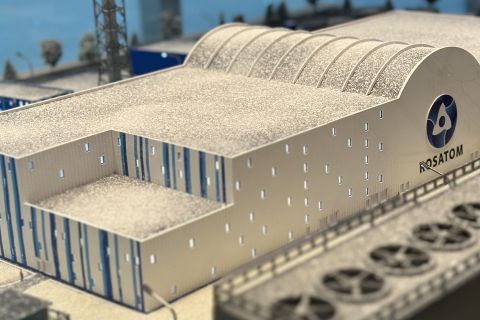
Rosatom obtained a license for the first land-based SMR in Russia
On April 21, Rosenergoatom obtained a license issued by Rostekhnadzor to construct the Yakutsk land-based SMR in the Ust-Yansky District of the Republic of Sakha (Yakutia).

ROSATOM and FEDC agree to cooperate in the construction of Russia's first onshore SNPP
ROSATOM and FEDC have signed a cooperation agreement to build Russia's first onshore SNPP in Yakutia.
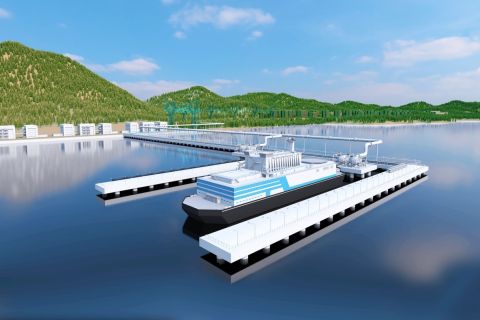
Rosatom develops nuclear fuel for modernized floating power units
Rosatom has completed the development of nuclear fuel for the RITM-200S small modular reactor designed for the upgraded floating power units.

IMAGES
COMMENTS
The route of Cook's first voyage. The first voyage of James Cook was a combined Royal Navy and Royal Society expedition to the south Pacific Ocean aboard HMS Endeavour, from 1768 to 1771.It was the first of three Pacific voyages of which James Cook was the commander. The aims of this first expedition were to observe the 1769 transit of Venus across the Sun (3-4 June that year), and to seek ...
James Cook's three Pacific voyages. James Cook (born October 27, 1728, Marton-in-Cleveland, Yorkshire, England—died February 14, 1779, Kealakekua Bay, Hawaii) was a British naval captain, navigator, and explorer who sailed the seaways and coasts of Canada (1759 and 1763-67) and conducted three expeditions to the Pacific Ocean (1768-71 ...
First Voyage of Captain James Cook. (1768 - 1771) James Cook's first voyage circumnavigated the globe in the ship Endeavour, giving the botanists Joseph Banks and Daniel Solander the opportunity to collect plants from previously unexplored habitats. Although the Endeavour voyage was officially a journey to Tahiti to observe the 1769 transit ...
Captain James Cook FRS (7 November [O.S. 27 October] 1728 - 14 February 1779) was a British explorer, cartographer and naval officer famous for his three voyages between 1768 and 1779 in the Pacific Ocean and to New Zealand and Australia in particular. He made detailed maps of Newfoundland prior to making three voyages to the Pacific, during which he achieved the first recorded European ...
James Cook: First Voyage. Act I: The First Voyage. Expedition (1768-1771): One ship (Endeavour), 94 men. Charge (by the Royal Society and the British Admiralty): To view the transit of Venus from Tahiti and then to look for the Southern Continent. Accomplishments: Viewed the 1769 transit of Venus, discovered the Society Islands, made the ...
James Cook's first voyage circumnavigated the globe in the ship Endeavour, and gave scientific members of the expedition an opportunity to collect specimens from previously unexplored habitats. Although the voyage was officially a journey to Tahiti to observe the 1769 transit of Venus across the sun, it also had a more clandestine mission ...
Endnotes. Charles J. Shields, James Cook and the Exploration of the Pacific (Philadelphia: Chelsea House Publishers, 2002), 16. Richard Hough, Captain James Cook (New York: WW Norton & Co., 1997) 38-39. James Cook, The Voyages of Captain Cook, ed. Ernest Rhys (Hertfordshire: Wordsworth Editions Limited, 1999), 11 Captain James Cook and Robert Welsch, Voyages of Discovery (Chicago: Academy ...
Cook's Voyages Map - Ages of Exploration. Cook's Voyages Map. Quick Facts: The map shows the three voyages of Captain James Cook. The first voyage is in red, the second voyage is in green and the third voyage is in blue. Following Cook's death, the route his crew took is in the blue dashed line. (Credit: Andre Engels)
The twenty-fifth of August 2018 marks the 250th anniversary of the departure of the Endeavour from Plymouth, England, and the first of three voyages by James Co...
05b James Cook (1772-75) In July 1772 Cook, now a commander, set out with HMS Resolution and Adventure with instructions from the Admiralty for "prosecuting [his] discoveries as near to the South Pole as possible.". First, though, he was to look for Cape Circumcision, mapped by French explorer Jean-Baptiste Bouvet de Lozier in 1739 and ...
The First voyage. It was Britain's greatest voyage of ocean exploration, mounted by the Admiralty and the Royal Society and forty-year-old Captain James Cook was entrusted with its leadership. On 25 August 1768, three months after taking command of the HM Bark Endeavour, he led the ship out of Plymouth Harbour. His destination was Tahiti, to ...
James Cook and his voyages. The son of a farm labourer, James Cook (1728-1779) was born at Marton in Yorkshire. In 1747 he was apprenticed to James Walker, a shipowner and master mariner of Whitby, and for several years sailed in colliers in the North Sea, English Channel, Irish Sea and Baltic Sea. In 1755 he volunteered for service in the ...
05a James Cook (1768-1771) When the Royal Society asked the Admiralty in 1768 to commission a voyage to the Pacific to observe the transit of Venus across the Sun, James Cook was their rather surprising choice of leader. Alexander Dalrymple who optimistically expected the great South land to begin south of the tropics and be populated with 50 ...
The first voyage. James Cook's first Pacific voyage (1768-1771) was aboard the Endeavour and began on 27 May 1768. Cook's voyage had three aims; to establish an observatory at Tahiti in order to record the transit of Venus (when the planet passed between the earth and the sun), on 3 June 1769. The second aim was to record natural history, led ...
Vue générale du premier voyage, 1768-1771. Carte du premier voyage de Cook dans l'océan Pacifique. Le premier voyage de James Cook fut un tour du monde effectué sur le navire HMB Endeavour.Les missions du capitaine James Cook étaient d'observer le passage de Vénus depuis l'océan Pacifique, puis de chercher des traces de l'hypothétique continent austral Terra Australis.
The first voyage of James Cook was a discovery expedition to the south Pacific Ocean, with aims of observing the 1769 transit of Venus across the Sun and seeking evidence of the alleged southern territories, named by that time as Terra Australis Incognita. The ship chosen for the voyage was HMS Endeavour.The makeup of the crew during the voyage varied due the high mortality, for which ...
Premier voyage (1768-1771) Commandité par la Royal Society de Londres, le premier voyage de James Cook a pour but d'observer à Tahiti, le passage de la planète Vénus Vénus sur le disque du ...
Ce travail de recherche explore comment l'environnement du Pacifique au dix-huitième siècle a influencé le premier voyage de James Cook aux Mers du Sud. Bien qu'une multitude de différentes investigations et de nombreuses biographies de Cook examinent cette exploration, il y a peu d'analyse de sa dimension environnementale. ...
Illustration by Julie Benbassat. On Valentine's Day, 1779, Captain James Cook invited Hawaii's King Kalani'ōpu'u to visit his ship, the Resolution. Cook and the King were on friendly ...
No:7 Kuşadası 09400 Aydın. + (90) 256 340 03 40. [email protected]. Mon - Fri: 9:00 - 18:00. Closed on Weekends. Istanbul Branch - Türkiye. Moscow - Russia. London - United Kingdom. New York - United States of America.
Sunrise, sunset, day length and solar time for Elektrostal. Sunrise: 08:37AM. Sunset: 03:56PM. Day length: 7h 19m. Solar noon: 12:17PM. The current local time in Elektrostal is 17 minutes ahead of apparent solar time.
To increase the NSR traffic is of paramount importance for accomplishment of the tasks set in the field of cargo shipping. This logistics corridor is being developed due regular freight voyages, construction of new nuclear-powered icebreakers and modernization of the relevant infrastructure. Rosatom companies are actively involved in this work.
Get directions to Yuzhny prospekt, 6к1 and view details like the building's postal code, description, photos, and reviews on each business in the building